This article may contain affiliate / compensated links. For full information, please see our disclaimer here.
If you are new to Arab countries, Tunisia is a good option to start with. You can get there in only 2 hours with a flight from a couple of European cities. Although Tunisia is often identified with beach holidays, there is much more to see: the world’s biggest mosaic collection, a stunning amphitheater, Berber villages and their underground houses, desert activities, canyons and oases, charming medinas, forts, and mosques. Only to see the highlights, you need to spend one week in Tunisia. It is possible to travel around by public transport except in the southern part, but a road trip in Tunisia is also much less challenging than in other Arab countries, like Lebanon. Here you find a 5-day, one-week, and 10-day road trip itinerary that, with a few days added, you can also use for backpacking in Tunisia.
- Visa to Tunisia
- Travel insurance to Tunisia
- Getting to Tunisia
- What is the best time to visit Tunisia?
- Books to read about Tunisia
- Interesting facts about Tunisia
- What is the most popular food/street food in Tunisia?
- Religion
- Language
- How to get around in Tunisia?
- Best local tours in Tunisia
- Is Tunisia a safe country?
- Is it safe to drive in Tunisia?
- How to dress up in Tunisia?
- Is Tunisia cheap? Yes, if you avoid tourist scams!
- The best Tunisia road trip itinerary 5 days, 7 days and 10 days
- Tunisia itinerary 10 days – road trip
- Day 1: Tunis
- Day 2: Tunis, Carthage, Sidi Bou Said, La Goulette
- Day 3: Uthina, Thuburbo Majus, Sousse
- Day 4: Day trip from Sousse: Monastir, Kairouan
- Day 5: El Jem, Sfax, Medinine
- Day 6: Ksar Hallouf, Ksar Hadada, Chenini, Ksar Ouled
- Day 7: Matmata, Douz, Tozeur
- Day 8: Day trip from Tozeur: Mos Espa, Chebika, Tamerza, Midès
- Day 9: Le Kef (El Kef)
- Day 10: Dougga, Tunis
- Read about other Arab countries (Iraq, Lebanon, Jordan)
Visa to Tunisia
Citizens of many countries can visit Tunisia for up to 90 days without a visa, including the countries of the European Union. Check out if your country is among the visa-free countries.
Travel insurance to Tunisia
I always use SafetyWing for my travels, an affordable medical insurance that covers almost every country except Iran, North Korea and Cuba.
Getting to Tunisia
Flights
The fastest option to go to Tunisia is to take a flight.
Tunisia Air has direct flights from several European cities in Spain, Italy, France, Germany, and other Arab countries.
Here you can check flights with Tunis Air.
Air France also has several flights to Tunis from Paris.
It is good to know that the low-cost airline Easyjet has a direct flight from Geneva to Enfidha-Hammamet for as low as 35- 50 Euro for one way. It could be a great option if you arrive from Geneva or combine it with another flight.
Check the new flight aggregator, Wayaway, which lists low-cost airlines and, with one click, the prices with or without luggage. Plus, you get some cashback each time you book a flight. To get an extra 10% off the membership fee, use my discount code: VOG. You can make the most of it if you book your trip (flights, hotels, and tours) through Wayaway’s link to booking.com, GetYourGuide etc., in which case the cashback really makes a difference. I tested and wrote a separate article about it.
You can also check flights on Skyscanner and Google Flights.
Via land
You can arrive to Tunisia via land from Algeria; Oum Teboul is the main border between Tunisia and Algeria. However, I don’t have personal experience with this border crossing.
Ferry
You can get to Tunisia from France and Italy, which is the cheapest option. The common ferry routes to Tunisia:
– Genoa or Civitavecchia (Italy) to Tunis (Tunisia)
– Marseille (France) to Tunis (Tunisia)
– Palermo (Italy) to Tunis (Tunisia)
From Palermo to Tunis, it takes around 12 hours and costs 40-50 USD. It becomes, of course, much longer and costs much more if you start from Genoa. The ferry from Marseilles also takes around one day and costs approximately 100-130 USD. There is no daily ferry, so you must carefully check the schedule in advance.
You can book your ferry ticket to Tunisia here.
What is the best time to visit Tunisia?
It depends on what you want to do. July – August is considered as peak season when prices are the highest and tourists arrive in masses.
However, if you plan a cultural roundtrip, either backpacking in Tunisia or making a road trip, you had better avoid both the summer and winter months. The temperature becomes unbearable in the desert during summer and gets surprisingly cold during winter, and most places don’t have heating. Since only a few tourists come at this time of the year, prices drop significantly.
For the deserted southern area, late September to November and March to early May is the best period. At this time, however, it is a bit cold to go swimming.
I was traveling around Tunisia from north to south at the beginning of May, when the temperature was pleasant, on some days, even hot. Once the temperature rose to 38 degrees in the southern part, so we decided to escape to Djerba island, which was only 100 km away, but it was even a bit too cool to enjoy the beach. I was surprised to see that Djerba has a different microclimate. Fortunately, the temperature dropped in the deserted part the day after, and we could continue our visit. As you see, high temperatures can still occur at the beginning of May, but generally, it is still not too hot.
It can be interesting to attend the Oasis festivals of Douz and Tozeur in December and January despite the colder temperature.
Books to read about Tunisia
Bradt Tunisia: the best and most up-to-date travel guide will be released in June 2023
Lonely Planet Tunisia: it is a good base but a bit outdated
Tunisia culture smart: You can learn about religion, history and life, and all the essentials before traveling to Tunisia
Tunisia, an Arab Anomaly: This excellent book gives you a better understanding of what makes Tunisia different from other Arab countries, its recent history, and its culture.
Interesting facts about Tunisia
– Tunisia has a Western-style working week with Saturday and Sunday off
– The Bardo Museum in Tunis has the world’s biggest mosaic collection (temporarily closed, check out if it reopened before your visit)
– Tunisians speak Tunsi, the local dialect that people of Arab countries outside the Maghreb don’t understand
– The first Arab country to adopt a constitution in 1861
– The only Arab country where nonbelievers are not prosecuted for apostasy
– Tunisia is one of the most progressive countries in the Arab world in terms of women’s rights
– The first non-European country to sign an association agreement with the European Union in 1995
– The Arab Spring that spread over the Arab countries started with the protests in Tunisia after the self-immolation of a vegetable seller in Sidi Bouzid
– “Harissa” is a hot chili pepper paste making most meals spicy
– The “English Patient” and the “Star Wars Trilogy” were shot in Tunisia.
– Olive trees are everywhere, making Tunisia one of the world’s biggest olive oil producers in the world
What is the most popular food/street food in Tunisia?
When we talk about Tunisian food, you must know about harissa. It is a red sauce made from dried crushed chili, garlic, and salt. Harissa is the reason why making almost every Tunisian food is spicy.
Regarding Tunisian cuisine, there’s much more than just couscous, the national dish of the Maghreb, which can be served with meat or seafood. While it’s a must-try, there are many other Tunisian specialties. Having an expansive coastline, seafood and different kinds of fish are easy to find. Tuna fish is also widely used in salads and sandwiches. As mentioned earlier, La Goulette, with a whole street of fish restaurants, is a perfect place to try it.
Merguez: spicy lamb or goat sausages
Ojja is a dish of eggs poached in a sauce of tomatoes, harissa, and onions. There are several ways to make it with sausages (merguez), seafood, chicken, or eggs.
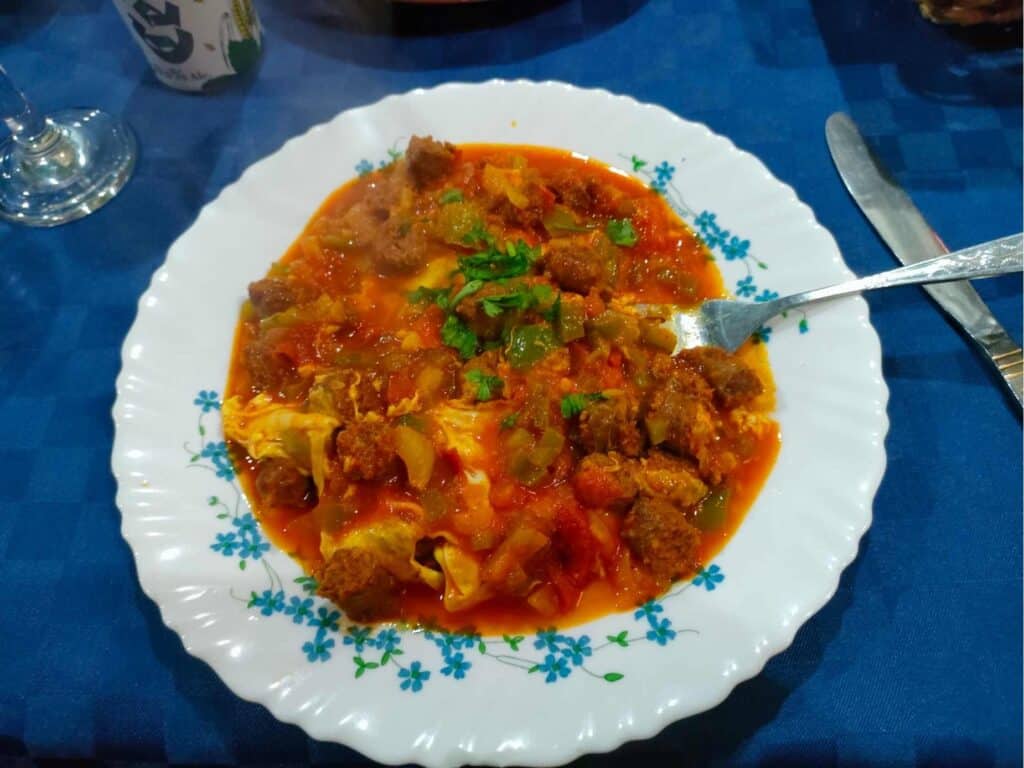
Tunisian street food
You can buy delicious sandwiches and wraps in Tunisia filled with tuna, chicken, kebab or liver, plenty of vegetables, and salad. They use different kinds of bread to make it. “Makloub” ,”Malouf,” or sandwiches with delicious Tunisian mlewi bread (folded and filled with harissa, cheese, eggs, tuna, and other ingredients) are one of the most common.
Brik: It is a thin, deep-fried pastry, usually filled with tuna, meat, egg, and cheese.
Fricassee: fried brioche filled with potato, harissa, tuna, black olives, hard-boiled egg, and Tunisian salad
Lablebi: Tunisian chickpea stew
Bambalouni: sweet Tunisian donut
Kafteji: popular Tunisian side dish made of pumpkin, potatoes, tomatoes, peppers, eggs, and salad Mechouia
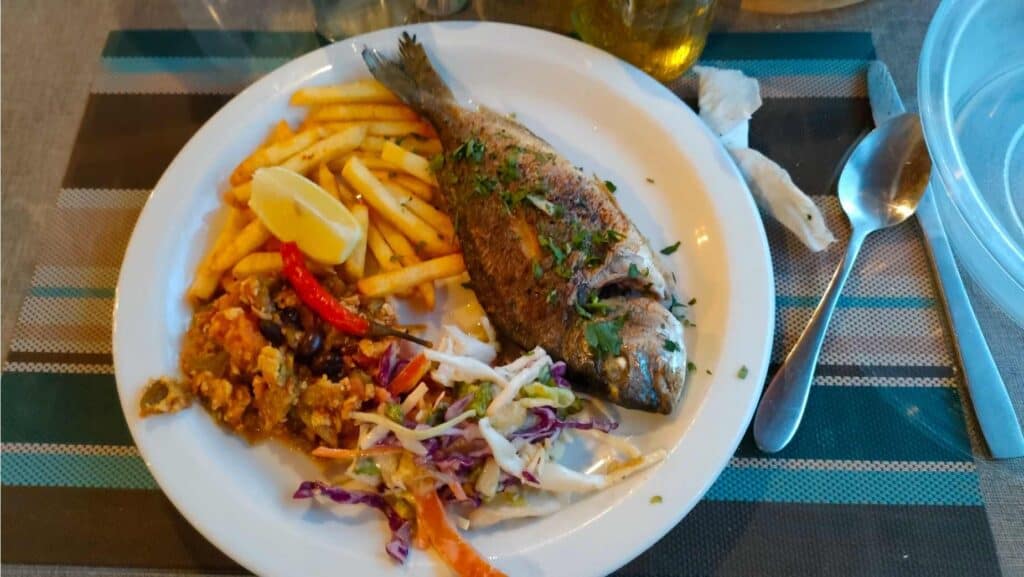
Salad Mechouia is a Tunisian grilled salad made with tomatoes, roasted red peppers, garlic, olive oil, and herbs, and of course.
There are plenty of good restaurants where you can taste local specialties, and the cuisine is one of the highlights of Tunisia. You can also join one of the following food tours:
Tip: If there is no menu, ask the price first to avoid being shocked by what they make you pay.
Mint tea: Since alcohol is not sold at every corner, mint tea is the most common thing to drink, even during hot summer days. It is special because they add pieces of almonds to that.
Tunisia has a self-brewed bier called Celtic.
Religion
It is the most homogeneous Arab country concerning religion. Almost the entire population is Arab and Sunni Muslim. However, the Islam of the Maghreb differs from the one practiced in the Middle East. It follows the Maliki school of jurisprudence and is influenced by Sufism and local traditions. Each town or community has a holy shrine (zaouia), which is considered an intermediate between men and God that they must honor to avoid any damage.
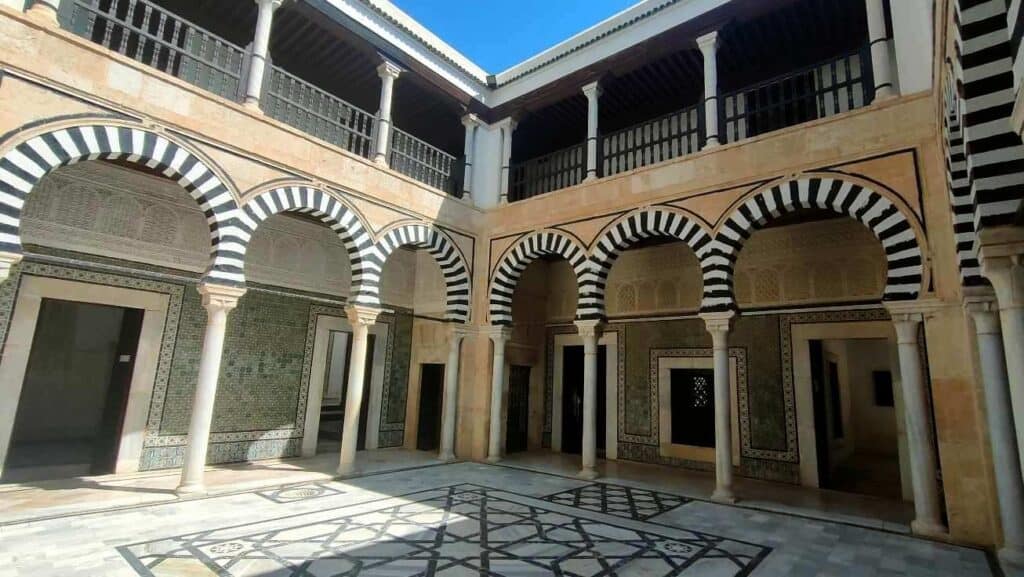
Tunisia is a secular state where Islam plays an important role but is not part of the governance. President Habib Bourguiba limited the teaching of Islam in primary schools to one to two hours a week, and it was almost eliminated in secondary schools. These classes focused on teaching the history of Islam, some of it even taught in French.
Tunisians are very different in their relation to religion. There are conservative religious people, mainly in the countryside, but in general, people enjoy quite big freedom in how they practice it.
Language
Arabic is the first language, but French is the language of business. Like most Arabic countries, Tunisia has its own dialect, called Tunsi Arabic, which is not understood in the Middle East. Tunsi is spoken, but standard Arabic is the written form. Tunsi Arabic borrowed Italian, Spanish, French, and Berber words. Berber is only used in a few places in the country’s extreme south.
If you speak French, you can get along well, as most Tunisians are bilingual. Young people in the cities also speak English, making Tunisia an easy country to discover for travelers.
How to get around in Tunisia?
It is easy to get around in Tunisia with trains and shared taxis (louages). Tunisia has several airports, all with connections to Tunis, but you need to check on which days.
Taking the train from Tunis to the southern cities until Tozeur is easy and a good option, especially that the railway stations are in the city center. However, as I made a road trip to Tunisia, I don’t have more information about that.
Here you can check the train schedule in Tunisia.
Lézard Rouge: you may have heard about the restored train of the former bey that makes a scenic journey around Tozeur. During my visit in May 2023, it was still closed without further plans to open it soon.
Louage
There are three shared taxi stations in Tunis, depending on where you want to go.
Best local tours in Tunisia
As I mentioned, the southern part of the country cannot be visited by local transport. Some places (the desert and Ong Jmel around Tozeur) are only accessible with 4×4. But there is a wide range of local tours available in Tunisia to choose from:
Desert tours from Douz (half-day, two days with overnight in a desert camp, quad tour, camel ride)
Day trip from Tozeur (Star Wars location, Chebika, Tamerza oasis and Mides canyon)
Visit the archeological sites of Carthage with bike
Private street food tasting in Tunis medina
Is Tunisia a safe country?
Tunisia is quite safe now, although the series of attacks in 2015 came as a surprise in the moderate Islam country. Also, in May 2023, four people were killed in an attack on Djerba island at the Synagogue during the annual Jewish festival despite the increased security control. It was the first attack after the one in 2002 when 21 people, many German tourists among them, were killed. I recommend not visiting Tunisia, especially Djerba, during this period of the year.
Be careful with pickpockets in the busy medinas and public transport. We were not once warned about putting away our mobile phones in the medina and the TGM by locals.
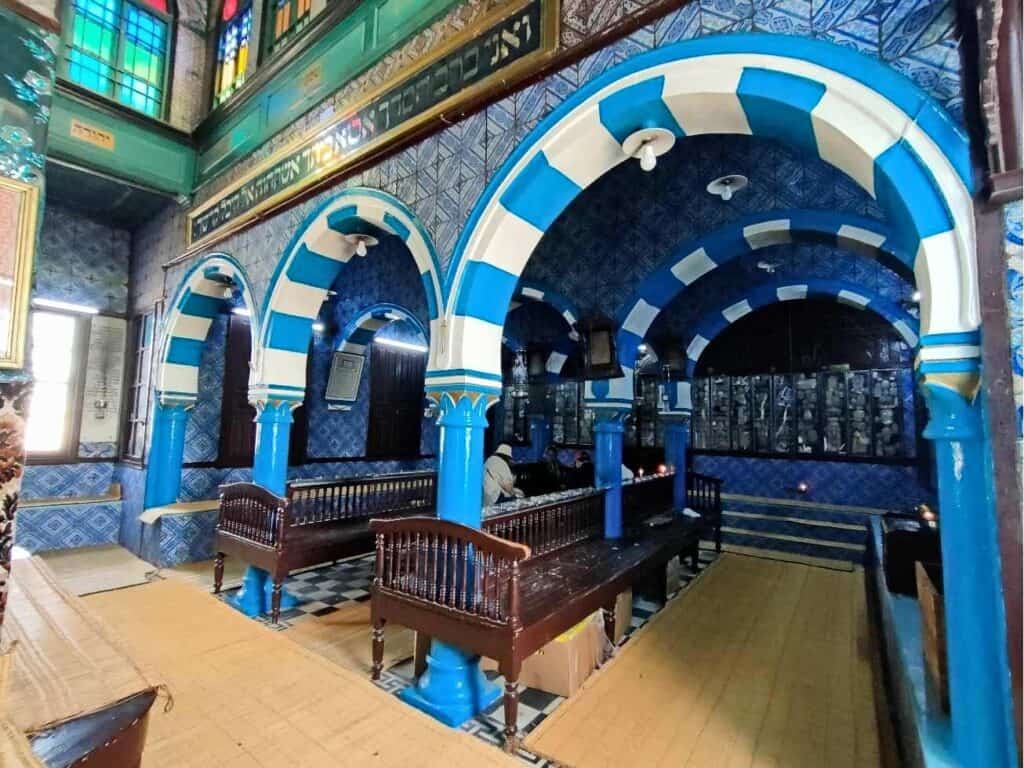
Is it safe to drive in Tunisia?
Yes, it is safe to drive around Tunisia, but be careful in Tunis, where the traffic is more hectic, and in general, don’t expect people to follow the traffic rules.
The Middle East and Arab countries, in general, have a reputation for having chaotic traffic, where people drive too fast and ignore the rules. But in Tunisia, a road trip is one of the best ways to discover the country.
Even if you are backpacking in Tunisia, in the southern part, you should rent a car or join a local tour as there is almost no public transport in the south.
How to dress up in Tunisia?
Even though Tunisia is a Westernized country with more relaxed rules than Iran, or other Arab countries, don’t forget you are in a Muslim country where you should still dress modestly if you travel outside your beach resort, especially in the more conservative countryside or the religious city of Kairouan.
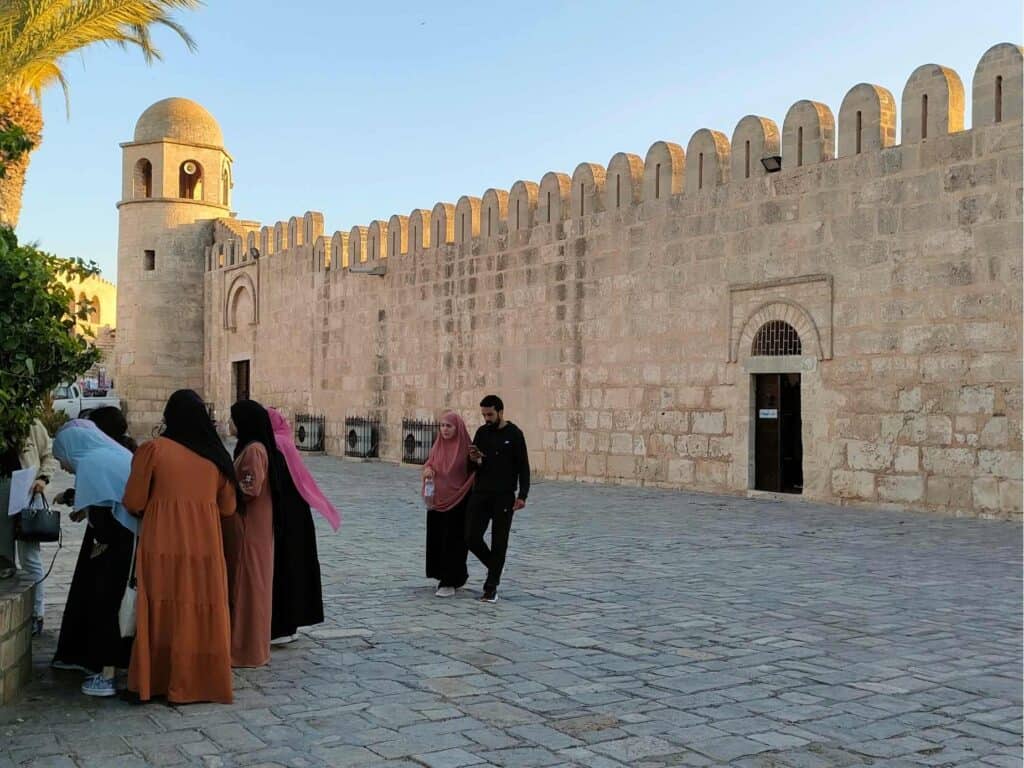
There are stricter rules at mosques, and you must cover your body and hair. However, don’t worry if you are not well-prepared; they usually give you a piece of cloth on the spot. Men are also required to wear trousers to enter a mosque. This rule applies even though foreigners are only allowed to enter the courtyard of the mosques and not the praying hall.
Is Tunisia cheap? Yes, if you avoid tourist scams!
Yes, Tunisia is cheap unless you fall into tourist traps that are almost impossible to avoid. This is one thing I don’t like about Tunisia; even in small shops, they can charge five times more than the actual price just because you are a foreigner. For that, it is always better to ask the price in advance, even when you buy a bottle of water in the supermarket or have a cup of coffee or fresh juice. Taxi drivers convince you that they drive with a taximeter to gain your trust but often trick the price in the end.
This happens immediately once you arrive at the airport. Here is the easiest to fall into the trap because, upon arrival, you don’t know much about the costs. I asked a Tunisian man sitting next to me on the plane about the fair price of a transfer to the city. He talked about it for 10 minutes, saying it is difficult for even him to avoid being cheated, and concluded that it is almost impossible for a foreigner.
He told me not to take a taxi right at the exit, but I should go upstairs instead, where taxis offer more reasonable prices. For some reason, the first floor was closed this time, so I had to negotiate with the taxis downstairs. It is only a 15-minute ride to the center, so it should be at most 30 TND. Upon departure from Tunisia, I paid even less, only 20 TND, for the ride. Late in the evening, prices can be 50% higher, though.
So how is it best to avoid taxi scams in Tunisia?
You should agree on the price beforehand to avoid tension and unnecessary arguments. It is a pity because first impressions are decisive when somebody arrives in a new country.
To give you an idea about the prices in Tunisia (1 $~ 3 TND):
Local beer (Celtic): 3.5-8 TND
A bottle of water (1.5 l): 900 cent
One liter petrol: 1.8 TND
Sandwich: 4.5 – 5 TND
Entrance fees: 2.5 – 12 TND
Budget accommodation: 55 – 120 TND for two persons
Car rental for eight days: 180-220 EUR
A main meal (ojja, couscous): 15-18 TND
A Fish or seafood plate: from 25 000 TND
A ride with the TGM to Carthage: ~1 TND
A taxi ride from/to the airport: 30 TND/20 TND
The price of accommodation depends on the season. I was in Tunisia in a lower season at the beginning of May.
The best Tunisia road trip itinerary 5 days, 7 days and 10 days
Tunisia itinerary 5 days:
Day 1: Tunis medina, Carthage, Sidi Bou Said (1 night in Tunis)
Day 2: Kairouan (1 night in Matmata)
Day 3: Matmata, Ksar Hadada, Chenini; Ksar ouled Soltane (1 night in Medinine)
Day 4: El Jem, Monastir, Sousse (1 night in Sousse)
Day 5: Sousse, Thuburbo Majus, Tunis/La Goulette
Tunisia itinerary 7 Days:
Day 1: Tunis, Carthage, Sidi Bou Said (1 night in Tunis)
Day 2: Thuburbo Majus, Sousse (1 night in Sousse)
Day 3: Sousse, Monastir, El Jem, Medinine (2 nights in Medinine)
Day 4: Medinine, Ksar Hadada, Chenini; Ksar ouled Soltane
Day 5: Matmata, Tozeur (2 nights in Tozeur)
Day 6: Ong Jmel, Chebika, Tamarza, Midès
Day 7: Kairouan, Tunis
Tunisia itinerary 10 Days
Day 1: Tunis (2 nights)
Day 2: Carthage, Sidi Bou Said, La Goulette
Day 3: Uthina, Thuburbo Majus, Sousse (2 nights in Sousse)
Day 4: Day trip from Sousse: Monastir, Kairouan
Day 5: El Jem, Sfax, Medinine (2 nights in Medinine)
Day 6: Medinine, Ksar Hadada, Chenini; Ksar ouled Soltane
Day 7: Matmata, Tozeur (2 nights in Tozeur)
Day 8: Ong Jmel, Chebika, Tamarza, Midès
Day 9: El Kef (1 night in El Kef)
Day 10: Dougga , Tunis
Tunisia itinerary 10 days – road trip
Day 1: Tunis
Tunis, the capital of Tunisia, has a couple of places to visit in the medina (old town) and the modern part along the Avenue Habib Bourguiba. While most people rush to the nearby sites of Carthage, Sidi Bou Said, it is worth spending a whole day just in Tunis to stroll around its medina, visit the Zitouna mosque and traditional Tunisian houses and try the Tunisian cuisine in one of the restaurants. Going through the Bardo Museum and its precious mosaic collection can also take some hours once they reopen it. (It was temporarily closed for almost two years during my visit in May 2023).
To make the most of your day, I recommend taking part in a local guided tour in the medina.
I wrote a detailed travel guide about how to spend one day in Tunis.
Where to stay in Tunis?
If you want to stay in traditional houses, look for the Dars, traditional Tunisian houses converted into hotels. They are available in different budgets and are similar to the Riads in Morocco.
Dar
These are typical Tunisian houses with a central courtyard that provides light and a spacious, cool area, even during hot days, with several surrounding rooms. Roof terraces were sometimes used for sleeping. You will encounter several tourist attractions and accommodations called “dar.”
Low budget hotels/hostels:
Dar Ya – a traditional Tunisian house with colorful tiles, an inner courtyard, and a rooftop with a perfect location in the medina. They have private rooms and single beds in a dormitory, but even private rooms have shared bathrooms.
Hotel al Karmel: I stayed in this newly renovated low-budget hotel outside but within walking distance from the medina. Rooms have a private bathroom and balcony, and breakfast is included in the price.
Mid-range hotels
Top-end hotels
Day 2: Tunis, Carthage, Sidi Bou Said, La Goulette
There are a couple of things to visit on a day trip from Tunis, which are easily reachable by public transport, and I recommend you do that in the following order to avoid crowds and walking in extreme heat among the ruins.
1. Carthage
Carthage had a glorious past, but its story ends with the Romans destroying it after a series of wars. The Romans rebuilt it, but all what remained may be disappointing. Even though the archeological site of Dougga is more impressive, you should still include it in your itinerary, as Carthage is where Tunisian history started. Plus, it has an excellent location along the Mediterranean coast with a different atmosphere packed with stunning villas for wealthy Tunisians, and it is home to the presidential palace.
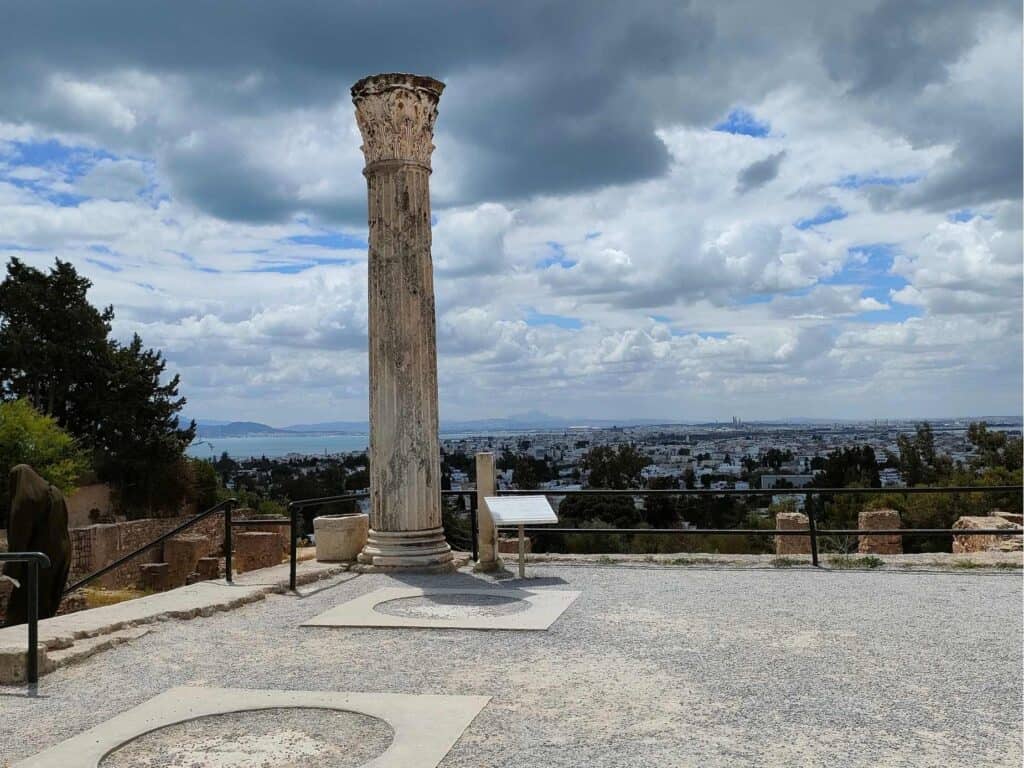
How to go to Carthage?
Carthage is located only 15 km from Tunis. You can easily reach it with the TGM. Carthage has more stops; you can take the one called Carthage Hannibal. From here, walk up to Byrsa Hill, which is centrally located among the ruins.
The TGM departs every 15 minutes, so you don’t need to wait long if you miss one. Depending on the distance you cover, it costs less than a dollar.
Short story of Carthage
The Phoenicians from Tyre (today’s Lebanon) founded Carthage in 814 BC, which became the largest Phoenician settlement. Rome and Carthage, the two great empires, fought for supremacy in the “Punic Wars” between 264 and 146 BC.
Carthage was the only ancient empire that could intimidate the Romans. In its heyday, its territory stretched across North Africa, from Algeria, Libya, and Tunisia to the coasts of Morocco and southern Spain, and it controlled much of the western Mediterranean, including Corsica, Sardinia, and much of Sicily.
Hannibal Barca, the most famous Carthaginian leader, reached the gates of Rome. For this reason, the Carthaginian Empire is usually identified with Hannibal. In the Second Punic War (218-202 BC), he left Spain at the head of an army of 90 000 infantry, 12 000 cavalry, and 37 elephants, crossed the Alps, and arrived in Italy, where he stayed for 16 years fighting against the troops sent by the Romans. However, he failed to capture Rome.
Book your half-day tour to Carthage, Sidi Bou Said
Tunisians still consider Hannibal a hero, many streets and cafes are named after him throughout the country.
Carthage had a glorious past, but its story ends when the Romans destroyed it after a series of wars, built a new city on the ruins, and ruled over the Mediterranean for another six centuries.
“Great Carthage waged three wars. It was still powerful after the first and still inhabitable after the second. It was no longer to be found after the third,” said the German playwright and poet Bertolt Brecht.
Carthage became the capital of a new Roman province named “Africa.” It produced more olives than Italy and provided 1/3rd of Rome’s grain supply. The province always encompassed a larger area, eventually lending the name to the entire continent.
After Rome and Alexandria, it was the third most important city of the Roman Empire. The Romans carried out massive constructions, built aqueducts, dams, bridges, irrigation systems, and the stunning amphitheater of El Jem.
Important: The Carthage Museum is temporarily closed due to renovations.
The entrance fee is 12 TND (~4$), for which you can see all eight archaeological sites. You can purchase this ticket at any attraction.
The archaeological sites are not located next to each other but are scattered throughout the city. The taxis in the area specialize in taking you to all the places in an hour and a half, and they also give a lot of information about the attractions. The price of this is 50 TND (~17$).
Things to do in Carthage
With your combined ticket, you can visit the ruins of ancient Carthage, though some of them are disappointing. The most interesting are the ruins of the Antoninus baths, the amphitheater, Byrsa Hill, the Punic ports, and the cemetery.
You can visit the following sites in Carthage:
– Byrsa Hill: In the Punic times, a temple dedicated to a Carthaginian God stood here. During Roman times almost everything from the Punic times was destroyed and replaced with the capital and forum.
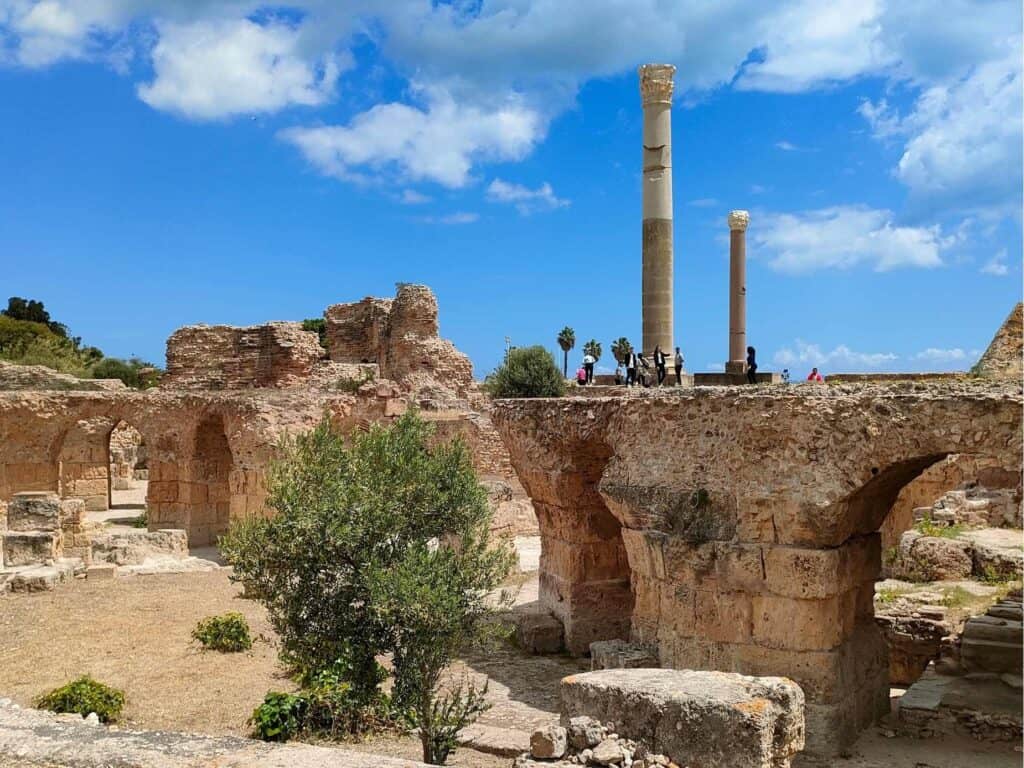
The Carthage Museum, which is currently closed, is also found here. The massive Saint Louis Cathedral (called Acropolium since 1993), dedicated to the French king who died during the 8th Crusade on the beach of Carthage, was built on top of an ancient temple of a Punic god. Constructing the city on top of the hill also provided great defense from the sea and land.
From here, you have a fantastic view of the coast. You can start your visit here and go from site to site with a taxi, join a bike tour, or go for a day trip including Carthage, Sidi Bou Said and Tunis medina.
– Punic Ports: Located down at the coast, the circular-shaped Punic ports were the main trading center of Carthage that you can drive by.
– Sanctuary of Tophet: a sacred place dedicated to Baal that contains numerous stelae. The Carthaginians used this place to sacrifice their children.
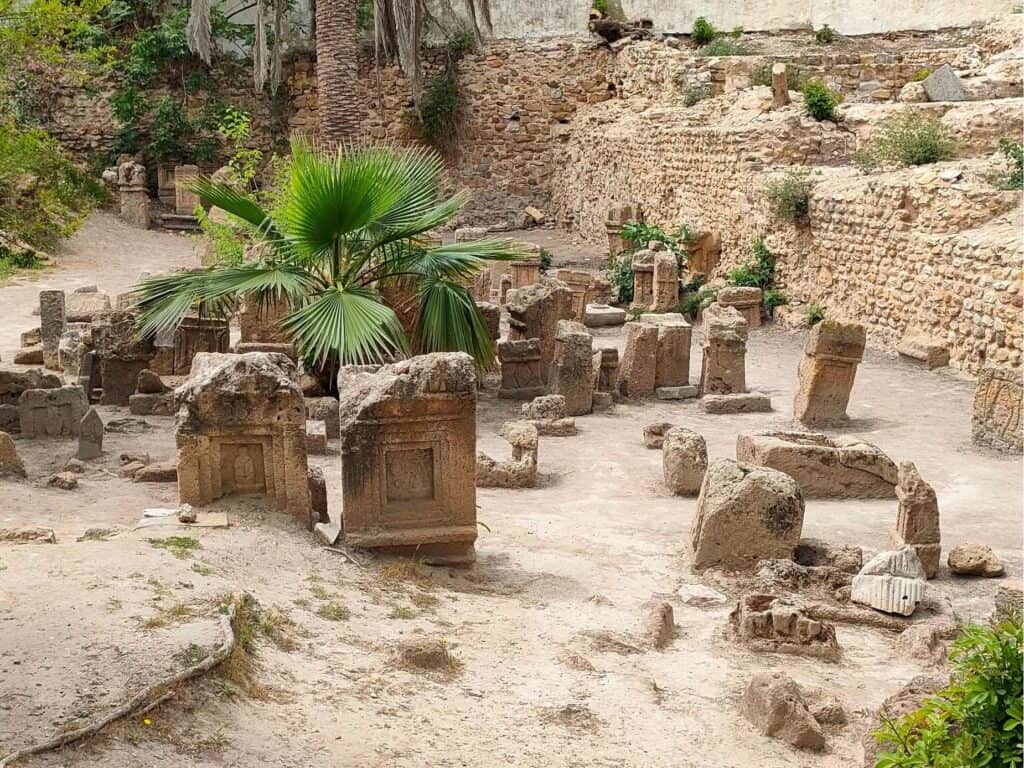
– Roman amphitheater: it was one of the biggest in the Roman Empire, with a capacity to accommodate 36 000 people. It is less spectacular than the one in El Jem, but it is still worth a visit.
– Baths of Antoninus: This is the most beautiful of all the archeological sites of Carthage and the biggest bath complex outside Rome. It had all the elements of a Roman bath of pools with hot, warm, and cold water.
– Theater of Carthage: Honestly, there is little left of the original, and it largely shows the result of reconstruction. The theater gives home to the annual Carthage International Festival, but it was one that we could have missed during our visit.
– Roman Villas: The ruins of the Roman villas are also found along the coast. This is also not something extraordinary.
Where to eat in Carthage?
Hotel Villa Didon is an exclusive place to eat with a stunning view.
2. Sidi Bou Said
This charming clifftop village is one of Tunisia’s most touristic places, just one stop from the Carthage station with the TGM. When you leave the station, the mosque and zaouia (tomb of a Sufi saint from the 13th century) stand at the entrance of the village. Go up the hill to get into the center.
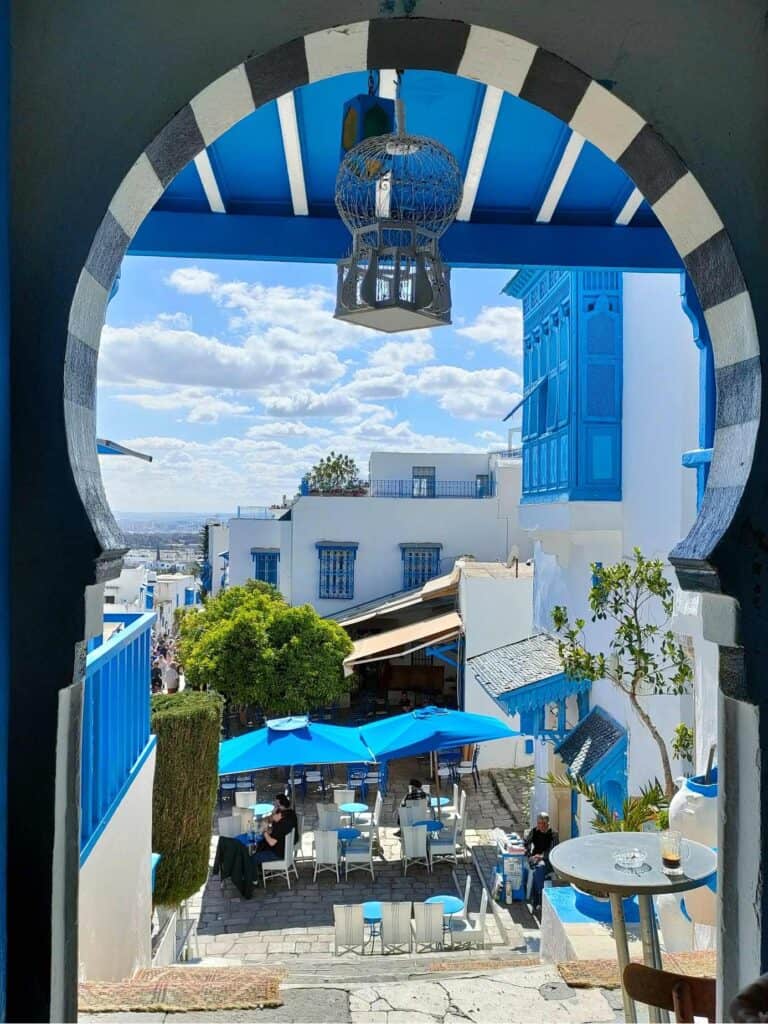
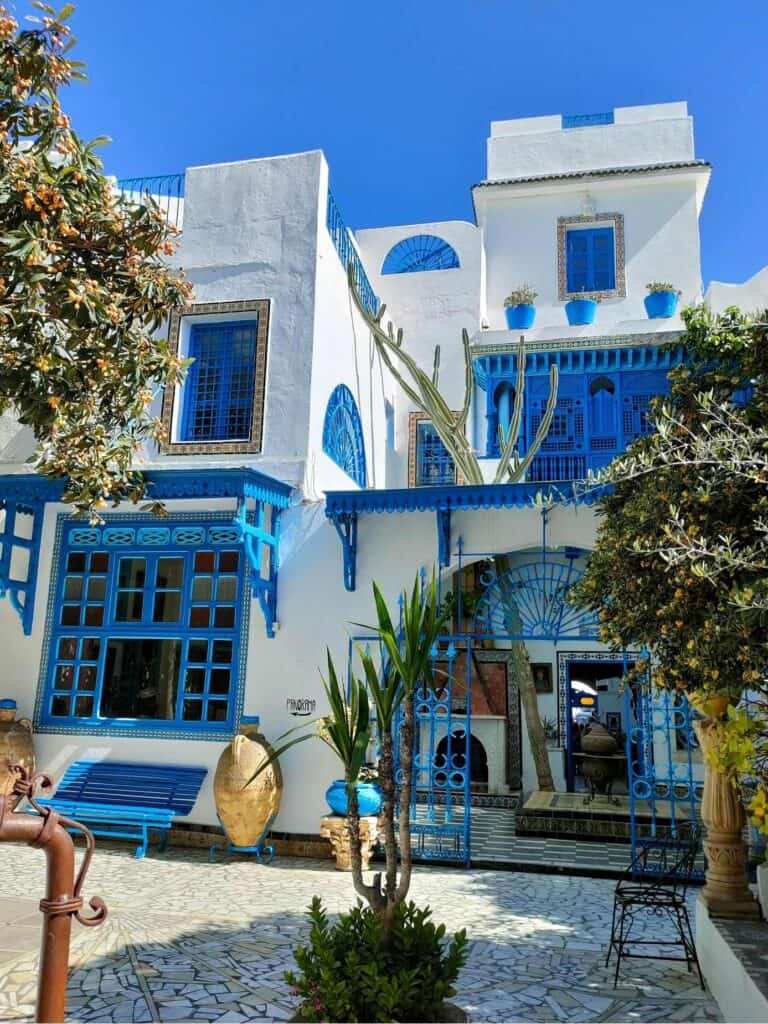
The village is famous for its white-painted houses with blue window grills and doors that follow an Andalusian pattern brought by Spanish Muslims who arrived in Tunisia in the 16th century. Plus, there is a spectacular view of the azure coast from the hilltop. It is well-known that Sidi Bou Said inspired Paul Clee to experiment with colors.
Sidi Bou Said has one main road dotted with cafes and souvenir shops, and if you follow the road, it will take you down to the coast with a nice walk. It is worth leaving the main street and looking at the side streets, where you get the feeling of the place without the “touristic hustle” and decoration.
There are two things worth seeing in Sidi Bou Said:
Dar el-Annabi: It is a lovely family home from the 18th century with interconnecting courtyards, small rooms, and a rooftop with a great view.
Entrance fee: 5 TND
Dar Ennejma Ezzahra: This house was the dream of the French Baron Rodolphe d’Erlanger and his Italian-American wife, who were dedicated patrons of arts and built it for ten years. The mansion of Arabian- Art Deco style contains a collection of old musical instruments and gramophones and stands in the middle of a garden with an adjacent terrace and a terrific view of the turquoise Gulf of Tunis.
Entrance fee: 5 TND
Don’t forget to try one of the famous cafés of Sidi Bou Said as well; just be careful as this is a hotbed of tourist traps. Ask the price before you order if you don’t get a menu. Otherwise, you can easily end up paying more than in any Western country.
Café des Nattes is one of the most famous, with mat seating inside and a small terrace outside. It was a well-known meeting place for French poets and philosophers.
Café Sidi Chabaane (Café des Delices): It is the most famous café with layers of terraces cut into the rock and the best view of the coastline. This is the most touristy place. It is also possible to take a photo and go to another cozy rooftop cafe.
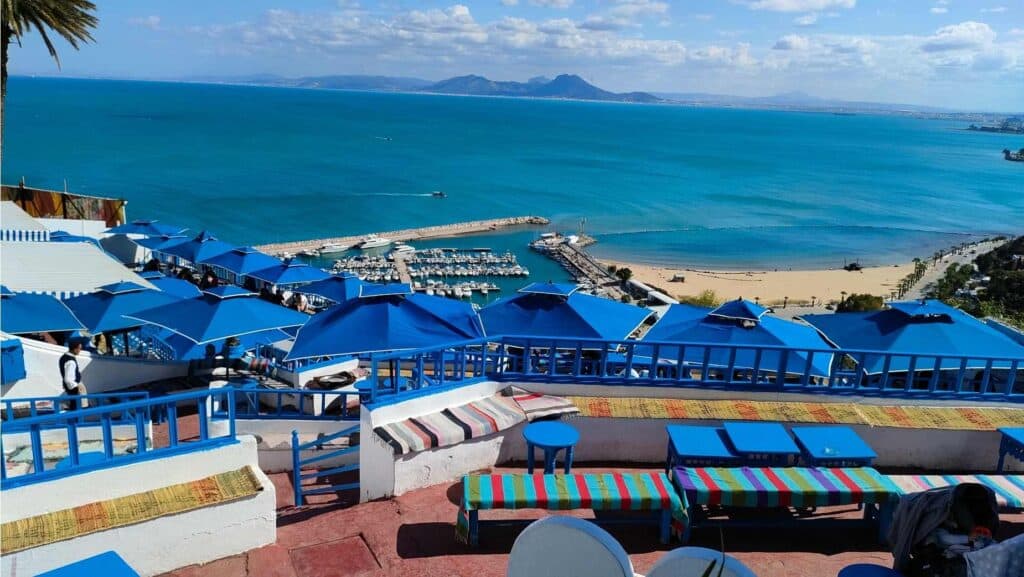
Where to eat in Sidi Bou Said?
“Au Bon Vieux Temps” is a charming restaurant with a splendid view and great food. Try a fricasseé or bambalouni for a quick snack from one of the small eateries near the Café des Nattes.
Book a full-day trip to Tunis medina, Carthage and Sidi Bou Said
3. La Goulette
Grab only a snack in Sidi Bou Said, as the best way to finish your day is to have dinner in one of the fish restaurants in the port city, La Goulette. At the weekends, all the restaurants get packed with locals. Most restaurants are casual but have a great atmosphere and the best place to try the fish in Tunisia.
We chose a menu with fish soup and appetizers, including the Tunisian brik, fish, and seafood. This cost 25 000 TND.
How to go to La Goulette?
La Goulette is the closest stop to Tunis, along the TGM.
Day 3: Uthina, Thuburbo Majus, Sousse
Uthina archeological site
I only heard about Uthina the day before from our driver in Carthage. Uthina was one of the oldest towns in the province of Africa that became a Roman colony for veterans. He showed some photos of this archeological site located 35 km from Tunis. It looked impressive in the pictures, so we decided to check it out. If you are fond of archaeological places, I recommend including this hidden gem in your itinerary.
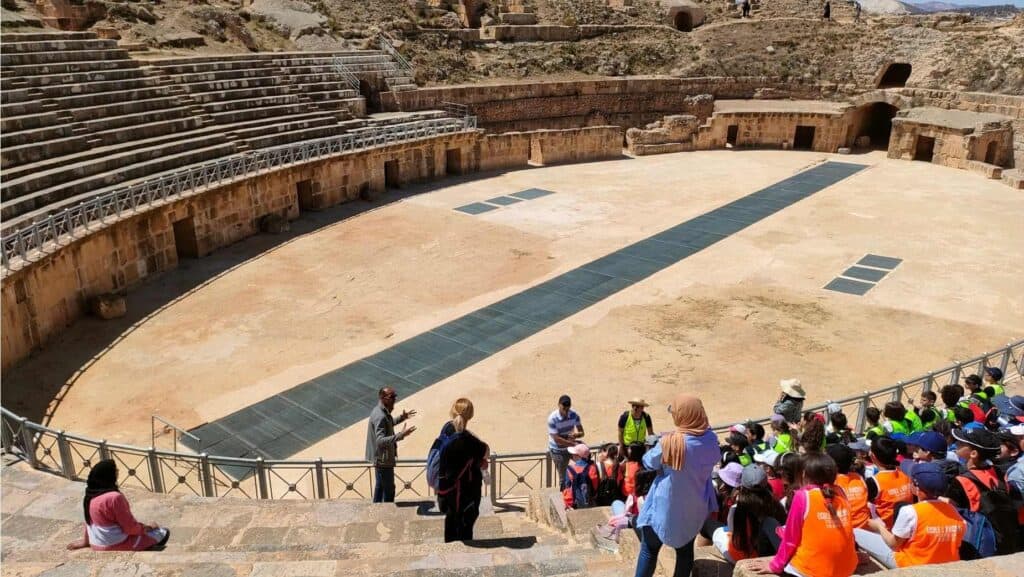
Although there was hardly any tourist, it seems popular among locals and a compulsory program for school children. There are a couple of things to see: the remains of a fortress, cisterns, an aqueduct, a triumphal arch, a theatre, an amphitheater, and a basilica with a collection of mosaics. The amphitheater in Uthina that could house 16 000 spectators is in surprisingly good condition. The film “Murder in Mesopotamia” after Agatha Christie’s novel was also filmed here.
How to get there?
There is no public transport to Uthina. You can only get there by car.
Thuburbo Majus
You may have never heard about it before. It was the same with me. Thuburbo Majus was one of the first Berber settlements under Phoenician control, while during Roman rule, it became an important trading center. The four giant pillars mark the entrance to the temple, and the baths still have some mosaics.
It is another secret archeological gem that you can include in your Tunisia itinerary before going to Sousse.
Sousse
The city has two interesting parts: the medina with the labyrinth of alleys and cobble-stoned streets, and the Boujaffar Beach with the lively corniche and a range of beachside hotels.
Great Mosque
Contrary to the common practice, it is not in the center of the medina and was built close to the ribat (fort) in the 9th century, which means it probably had a military function as well. It even lacks a minaret. This can be explained by the presence of the nearby fort, which had a tower from where the prayer could be called.
Opening hours: 8- 14.30
Entrance fee: 5TND
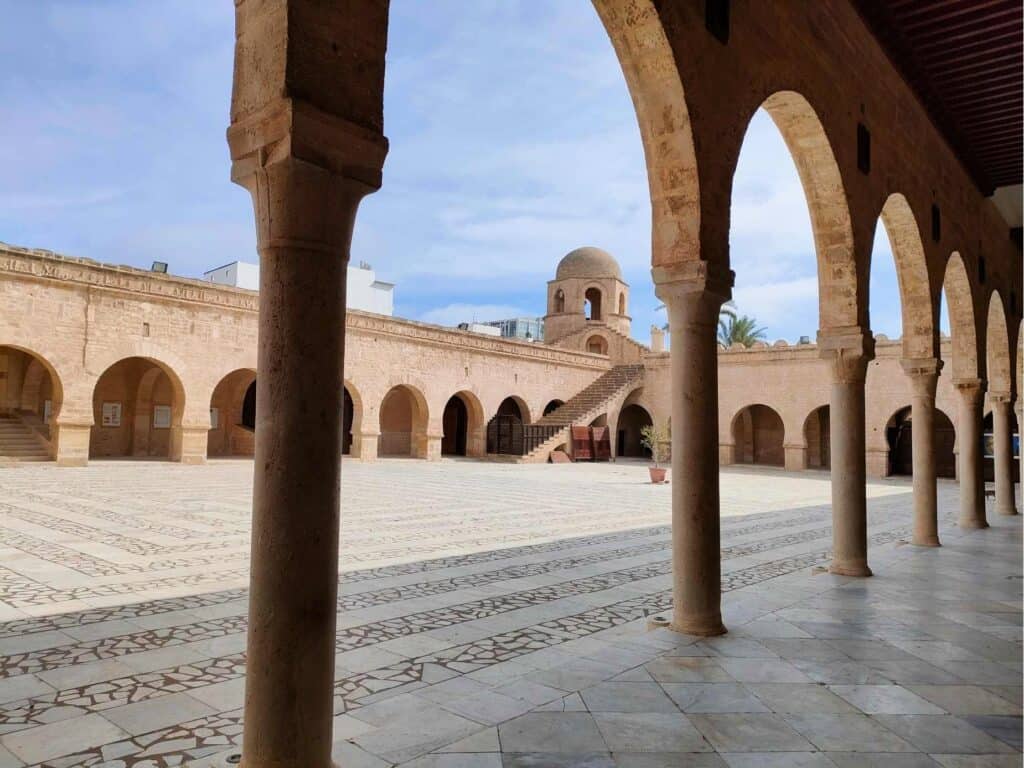
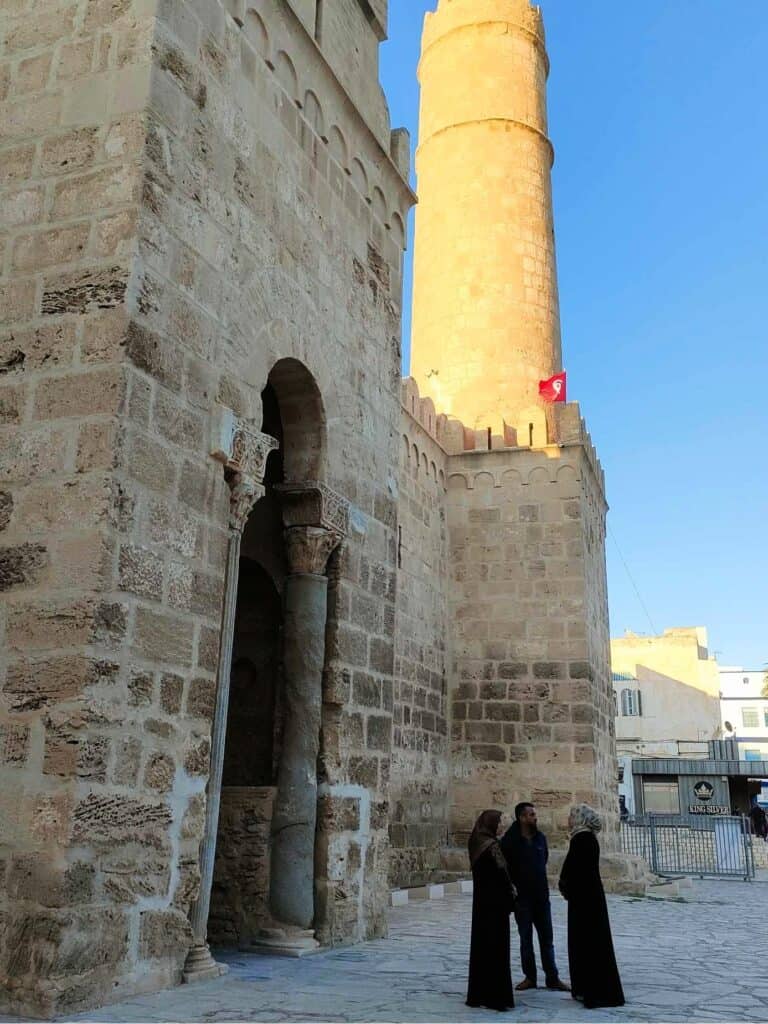
Ribat
The oldest building in the medina from the 8th century is close to the Great Mosque.
Kalat el-Koubba
It is a former caravanserai with rooms around the inner courtyard where traders could exchange goods and stay overnight, dating most probably to the 11th century.
Museum Dar Essid
The family home of a wealthy family from Sousse with furniture from Europe, marble from Carrara, and exclusive pieces of interior decoration is one of the best things to check out in the medina. Enjoy a nice view of the city from the rooftop café!
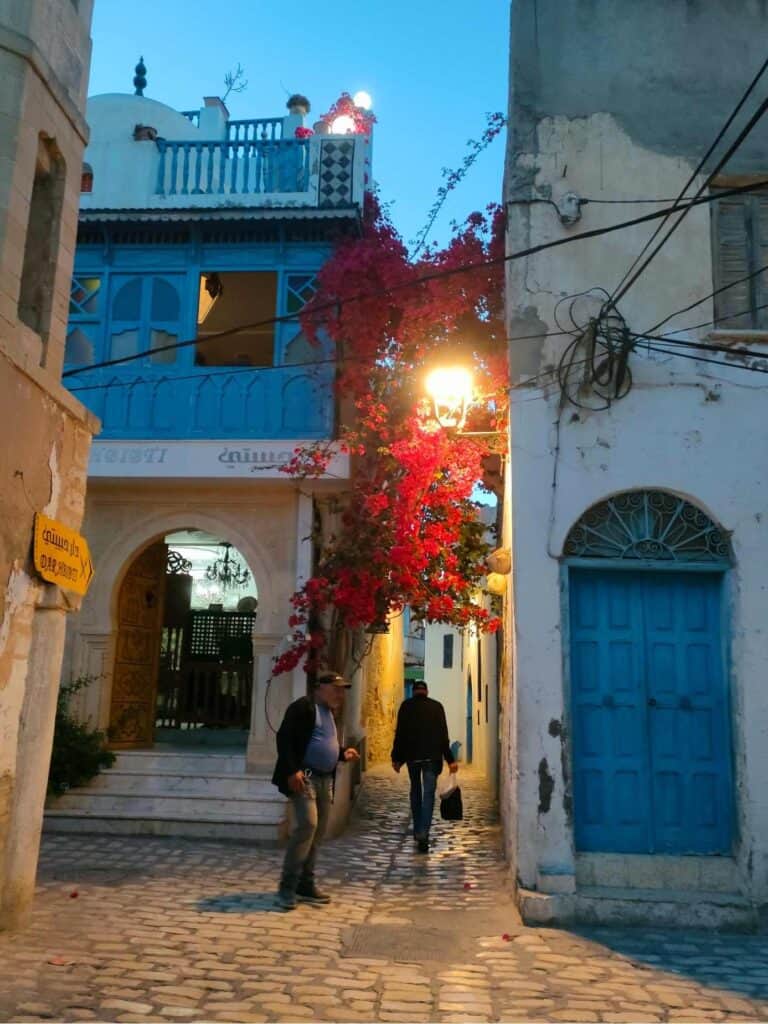
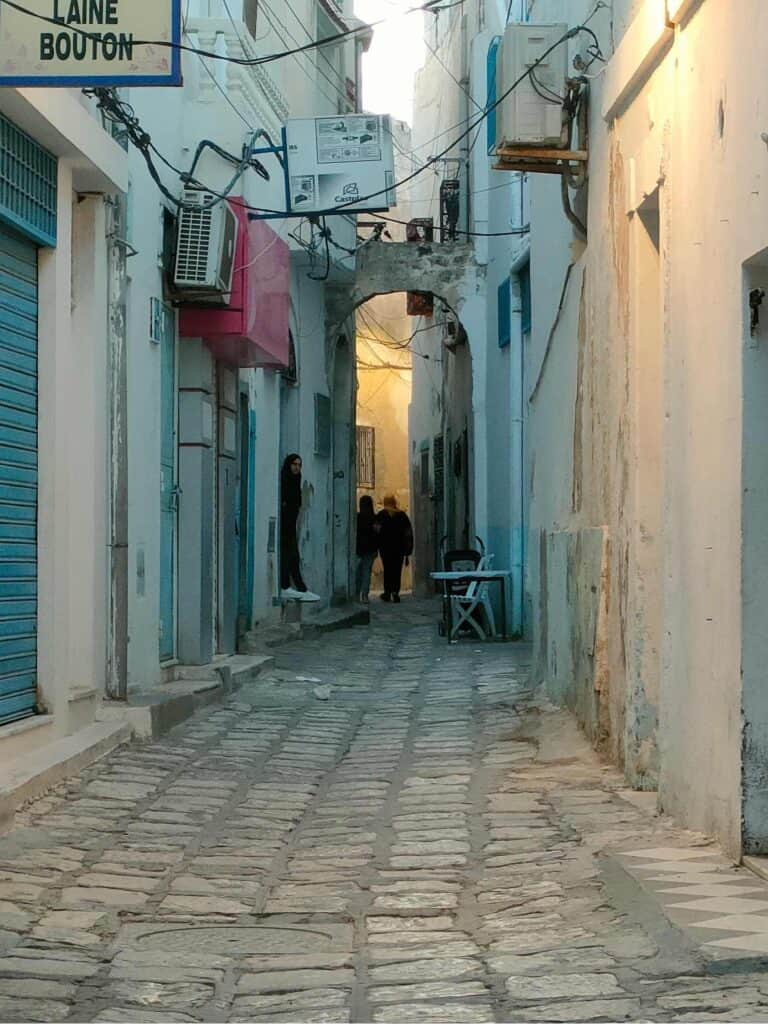
Sousse archeological museum
Sousse has a surprisingly rich collection of mosaics that is worth visiting. If the Bardo Museum in Tunis is not open during your visit, you can check this instead. It has one of the best collections of mosaics in the country.
How to get to Sousse?
You can take a train, bus or louage to Sousse. However, I don’t have more information about that as we rented a car for the rest of the trip.
You may wonder if it is not worth making a stop in the popular resort Hammamet. Well, I did, and unless you plan an exclusive beach holiday, I would not recommend an extra visit. It has an attractive medina right at the coast, but very small, with some souvenir and carpet shops. So many other medinas are bigger, more authentic, and more lively than the one in Hammamet.
Port el Kantaoui, the other resort town along the coast, disappointed me with its artificial fort wall, pirate ships, restaurants, hotels, and shops. Unless you go on a boat trip, it is not really worth including it in your Tunisia itinerary if you also look for authentic travel experiences like me.
Where to sleep in Sousse?
Low-budget: Hotel Paris is the most popular low-budget accommodation for backpackers that offers beds in dormitories or private rooms with shared bathrooms.
I stayed in Hotel Medina, a simple traditional hotel in the medina next to the mosque, and I highly recommend it. It was important for us that the room has a private bathroom. Plus, breakfast was also included in the price.
Hotel Soussana is located along the beach of Sousse, within 30 minutes walk from the medina.
Mid-range: Dar Lekbira Boutique Hôtel
Day 4: Day trip from Sousse: Monastir, Kairouan
Have a day trip to the popular resort, Monastir, and to Kairouan, with the oldest mosque in Tunisia.
Monastir
Monastir, located only half an hour from Sousse, is one of the famous resort towns of Tunisia but without a charming medina. It is still worth a quick visit for two things:
Ribat (fort) of Monastir
This is the most impressive fort in Tunisia. The fortress has several tunnels and alleys that sometimes become confusing, but it just makes it fun to discover. It was initially built in the 8th century but has undergone several reconstructions. Make a big round, and climb up to the top of the tower if you don’t have vertigo for the best view of the city and the coastline.
Entrance fee: 8 TND
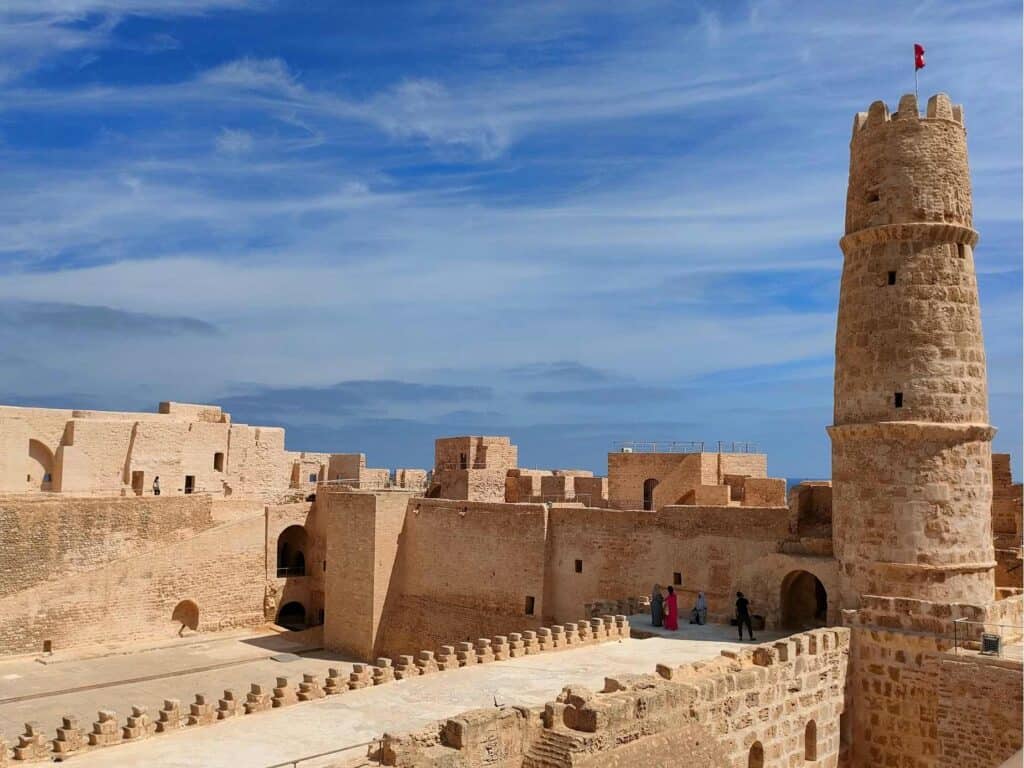
Mausoleum of Bourguiba
Next to the fort, a distinct paved road leads to the final resting place of the former president, Habib Bourguiba (1956-1987). The whole complex with the gate surrounding it is probably Tunisia’s most impressive modern structure. One can tell that they didn’t spare money for that.
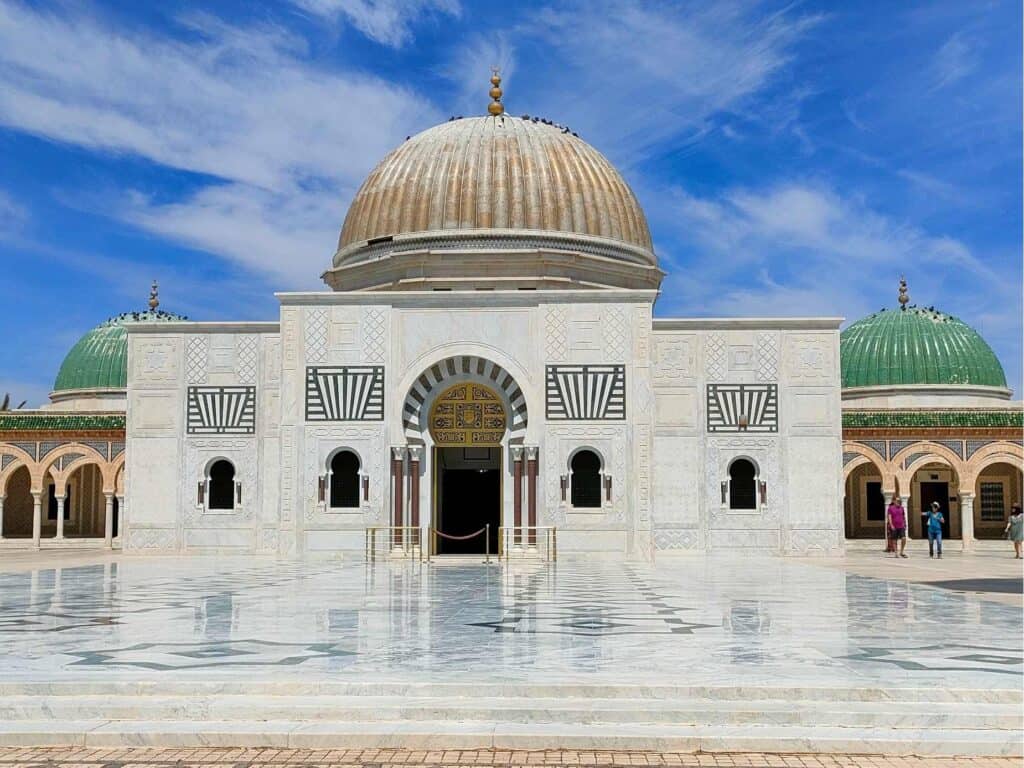
Inside, there is a small museum with photos of his life, official meetings with other heads of state, such as Saddam Hussein Iraqi or King Hussein, Jordanian king, and some of his attires and personal belongings. Take the stairs inside the gallery to see the intricately carved tomb from above.
The bronze door of his mausoleum indicates: “The Supreme Combatant, the Liberator of Women, the Builder of Modern Tunisia.”
Habib Bourguiba (President of Tunisia: 1957-1987)
Habib Bourguiba was one of those that expressed their discontent under French control. He attended the Sadiqi College and studied law and political science at the Sorbonne. Upon his return in 1927, Bourguiba became an activist. He wanted to transform Tunisia into a modern secular state where Islam is part of traditions, but religion does not interfere in government matters, so he banned Sharia law accordingly. He controlled religion and significantly reduced the number of religions in classes, prioritized education and adopted French-style university standards. Bourguiba’s name pops up everywhere, and people usually remember them for the positive path on which he set the country. Under his presidency, Tunisia emerged as the country with the most liberal-minded people in the Arab world, with well-educated citizens. Bourguiba died in 2000 at the age of ninety-six, having lived his last years in his place of birth, in the coastal town Monastir.
Sousse- Monastir: 22 km (30 min)
Monastir- Kairouan: 70 km (1h 10min)
Kairouan
Did you know thanks to the Mosque of Uqba (the other name of the Great Mosque), Kairouan is supposed to be the fourth holiest city in Islam after Mecca, Medina, and Jerusalem? Kairouan is the oldest Muslim city in Africa, built during the Arab contest in the middle of the 8th century, from which Islam spread to sub-Saharan regions. However, the first inhabitants of Kairouan were Christians and Jews, and until the French arrived, Muslims were prohibited from living in the city. It became the center of Islamic learning when the Great Mosque was built. Even when the capital was transferred to Tunis, Kairouan preserved its role as the Maghreb’s holiest city. Kairouan is a UNESCO World Heritage Site and one of the best places to visit in Tunisia.
Kairouan is famous for two products: carpets and bread. It means that there are countless carpet shops around.
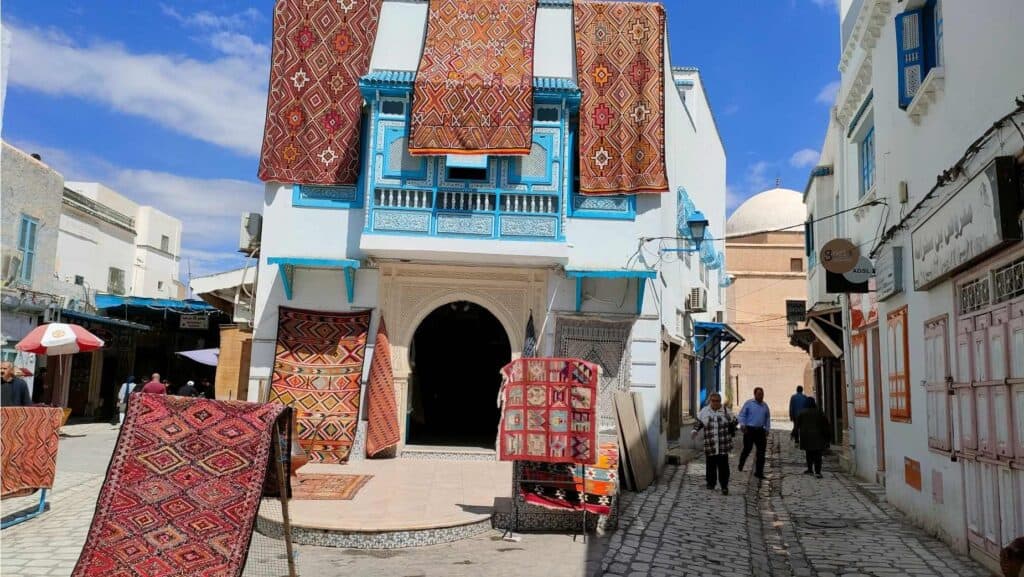
Medina
Kairouan’s medina is unique in Tunisia. It is pretty big, so it takes time to discover. A lively souk occupies most of it, where you can buy textiles, souvenirs, fruit, and pretty much everything. But the real life of Kairouan begins when you leave the central bazaar and turn into the side streets. Women go shopping, the fresh bread is being baked, men sit in the cafés, mechanics repair something, and carpetmakers work on the loom making carpets in the traditional way. Kairouan’s medina is a mix of authentic and touristic. Often you bump into a Tunisian courtyard decorated with tiles or a zaouia, the tomb of some holy person. Apart from the main souk, the side streets are quiet, and you quickly lose your orientation. But this is the best way to get the feeling of the medina.
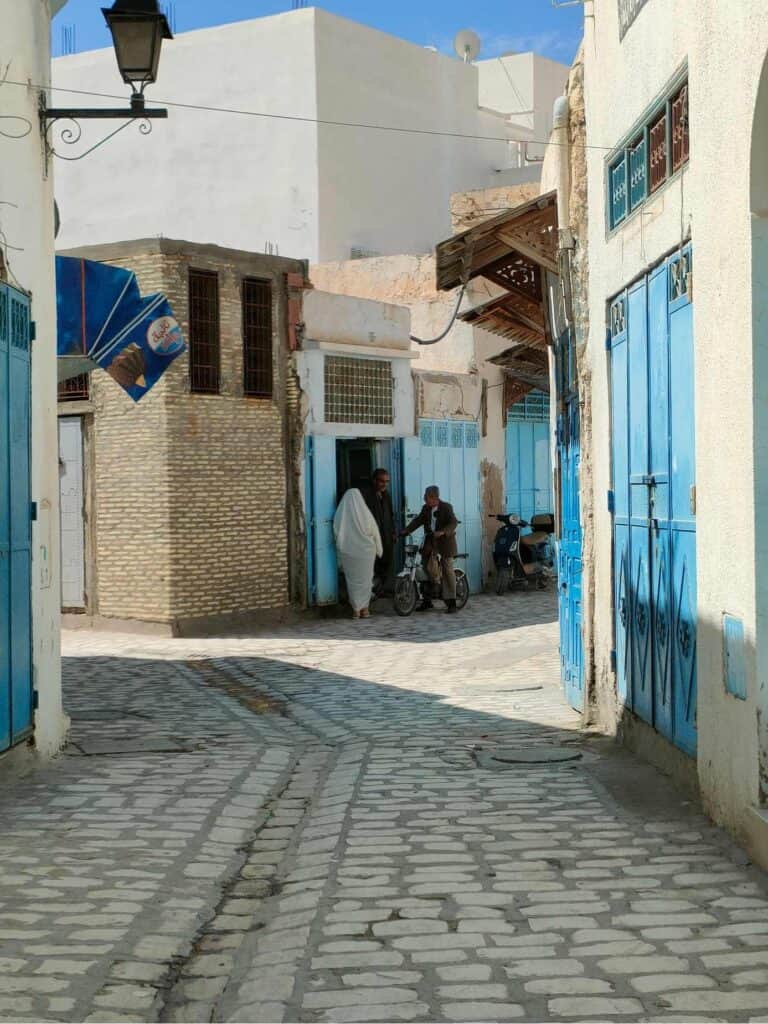
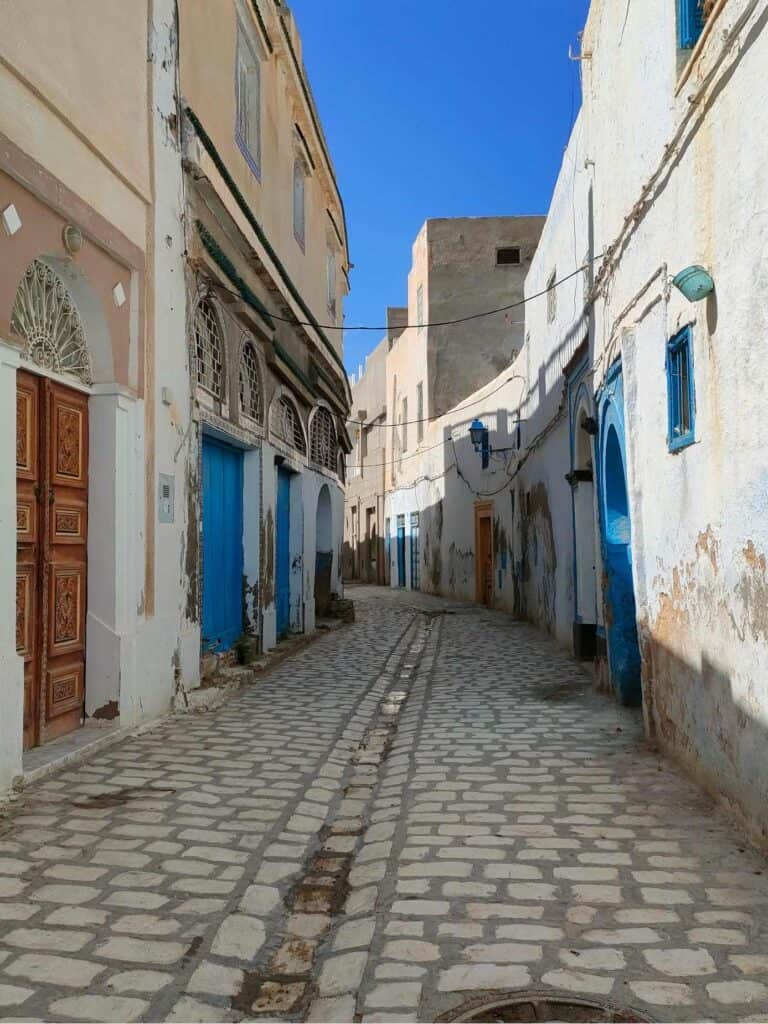
Great Mosque of Kairouan – the biggest attraction of Kairouan
The mosque looks more like a fortress with its massive walls. Even the building materials and techniques reveal that the mosque was meant to play a defensive role.
It was not a simple place of worship but also a school, a forum for theological discussions, served as a court, and a place where governors were elected. Students learned to read the Quran and other subjects, such as mathematics, grammar, medicine, and astronomy. Thanks to its precious library, it was considered one of the most important centers of learning in Islam, with Kufa in Mesopotamia and Medina in the Arabian Peninsula. Don’t forget to visit the ancient Muslim cemetery right behind the mosque.
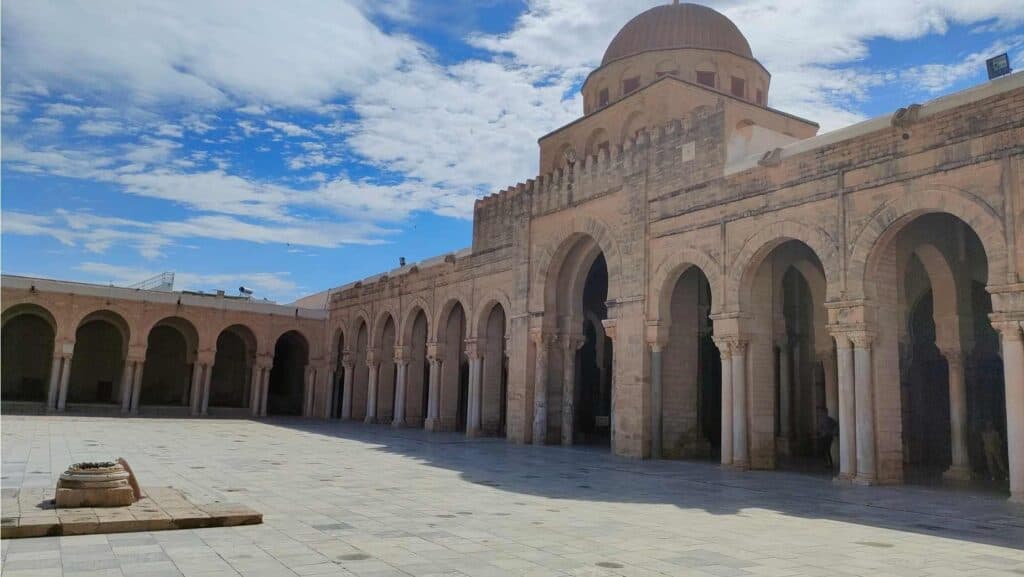
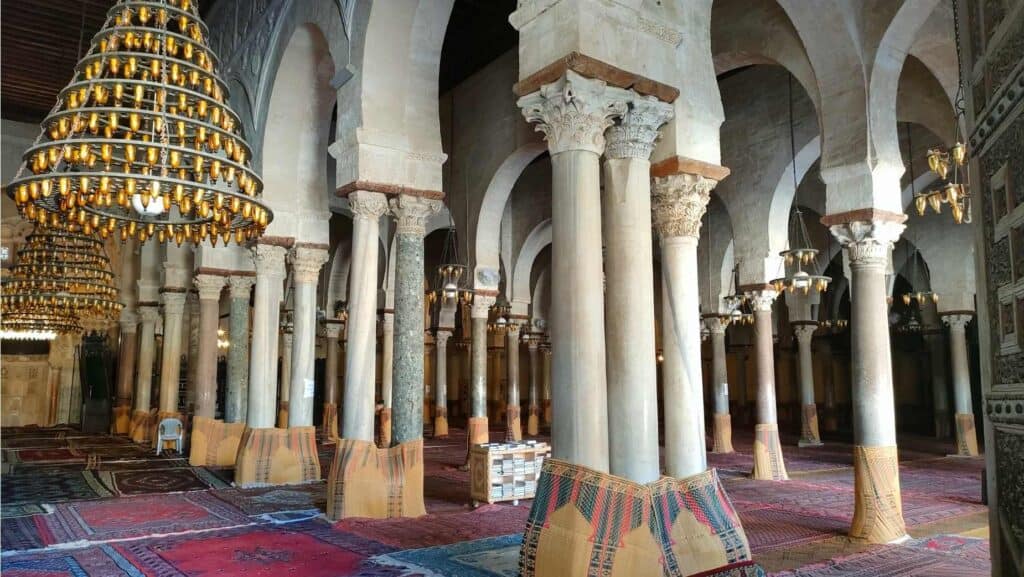
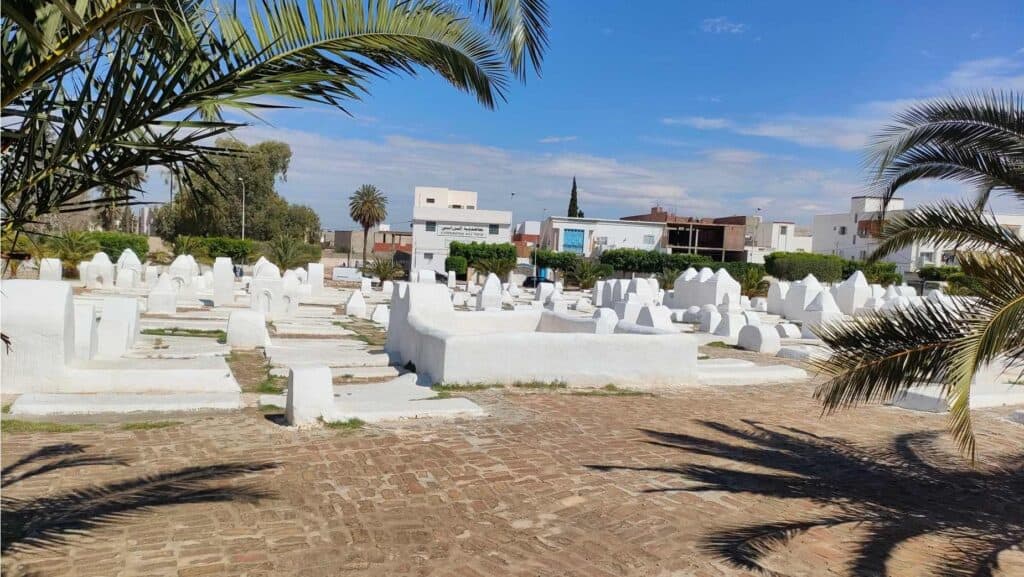
How to dress for visiting the Kairouan mosque?
As everywhere in Tunisia, non-Muslims are not allowed to enter the prayer hall, but you can see everything from outside.
You must dress up modestly; men should wear long trousers, and women should cover their whole body and hair. If you don’t come in appropriate cloth, you will get a veil or piece of cloth at the entrance.
Entrance fee: 12 TND
Opening hours: 8am-2pm Saturday-Thursday, and 8am-noon on Friday
You can visit a couple of other things indicated on the same ticket.
Some people around the mosque will probably come to invite you to the rooftop of their shops with a nice view of the mosque. They don’t ask for any money but hope that you buy something.
Other places to visit in Kairouan
Zaouia Sidi Abid al-Ghariani – in the medina
It was founded as a madrasa by a Kairawani scholar called Al Jadidi. He died during his pilgrimage to Mecca, and his student Abou Samir Abid continued his work as a teacher for 20 years. He was buried at this place.
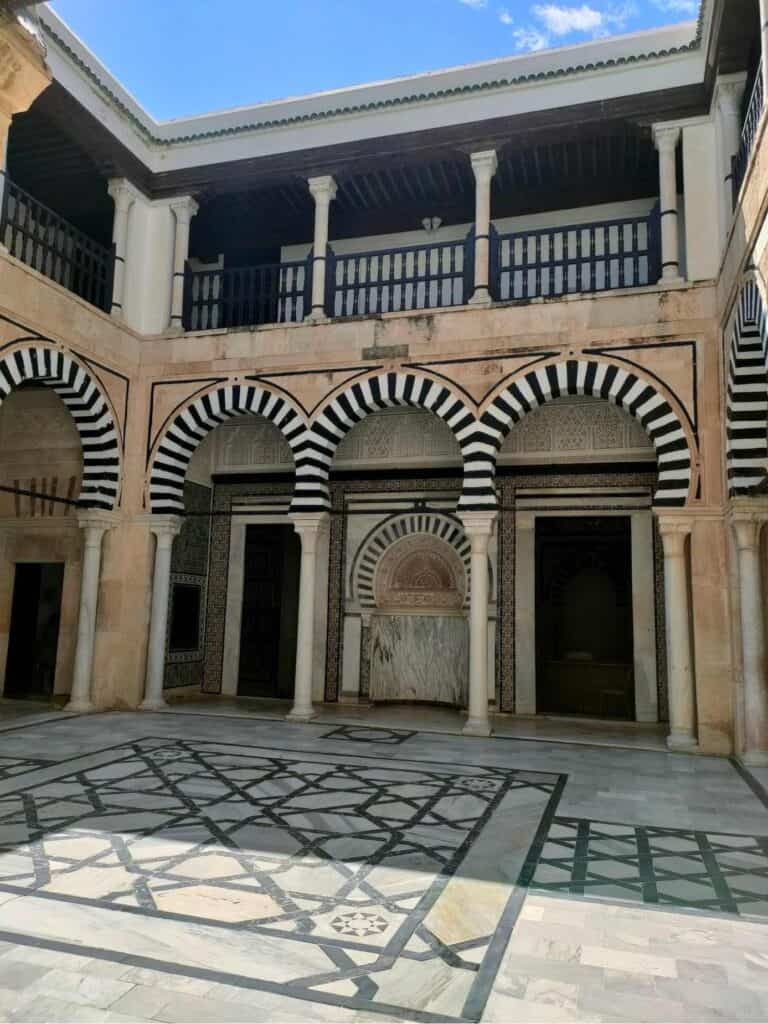
Mosque of the Barber (Zaouia of Sidi Sahab) – outside the medina
It is the mausoleum of Sidi Sahab, the companion of Prophet Muhammad who, according to a legend, had saved for himself three hairs of Muhammad’s beard, hence the strange name of the site.
Zaouia
The small white-painted structures throughout Tunisia are the tombs of marabout (Muslim holy men). In the Islam practiced in Tunisia, Sufi traditions play an important role, and they often visit the tombs of these highly respected persons. It usually contains a prayer hall and sometimes accommodation for visitors. The best examples are in Kairouan.
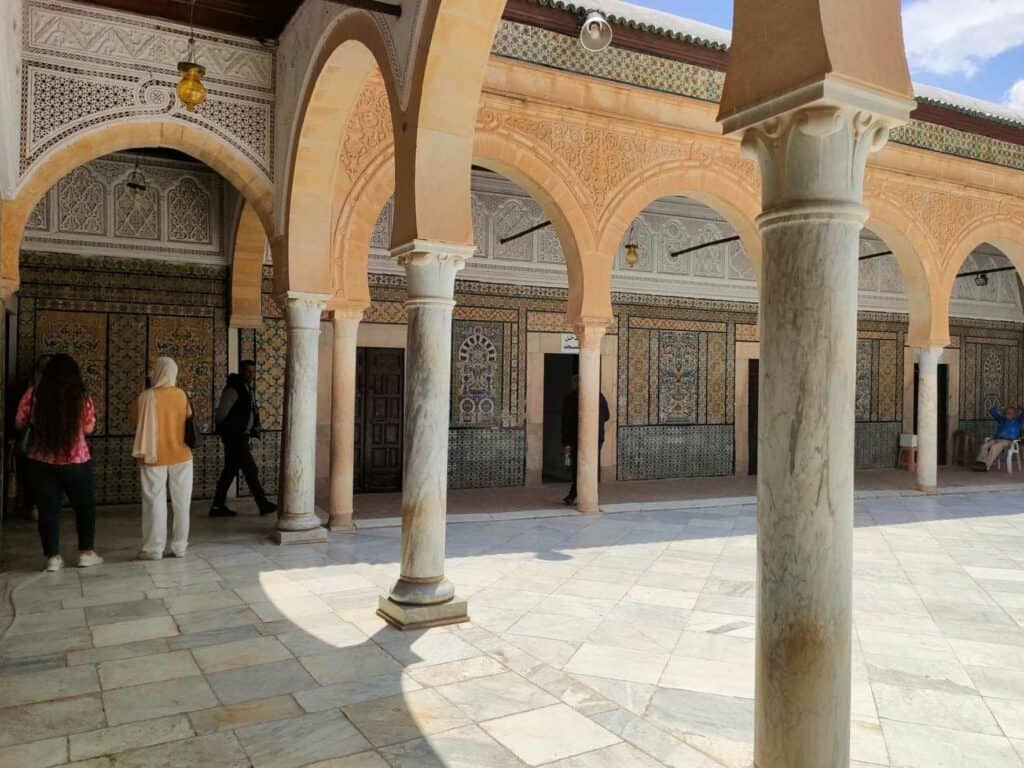
Aghlabid basins – outside the medina
The cisterns from the 9th century built by the Aghkabids collected the water carried by an aqueduct from 36 km. It was an engineering masterpiece at that time and unique in the Muslim world.
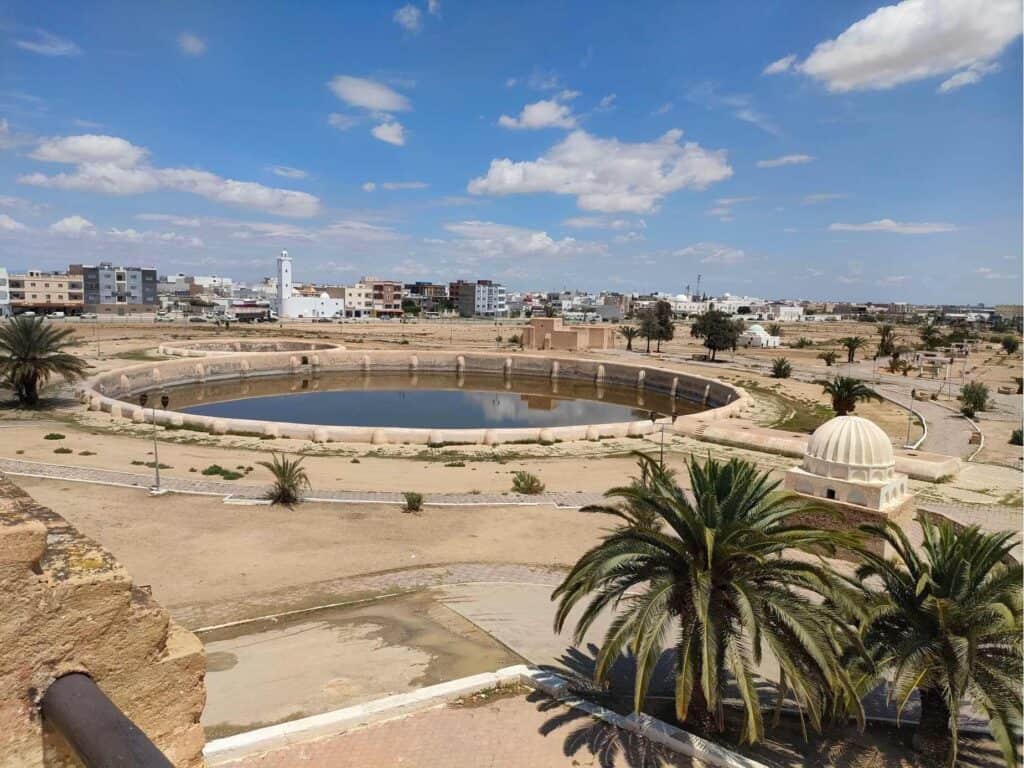
Mosque of the three doors – inside the medina
You can only visit it from outside as it is permanently closed to visitors. Anyway, the unique thing about the mosque is that it was one of the first examples of a richly decorated façade in Islamic architecture.
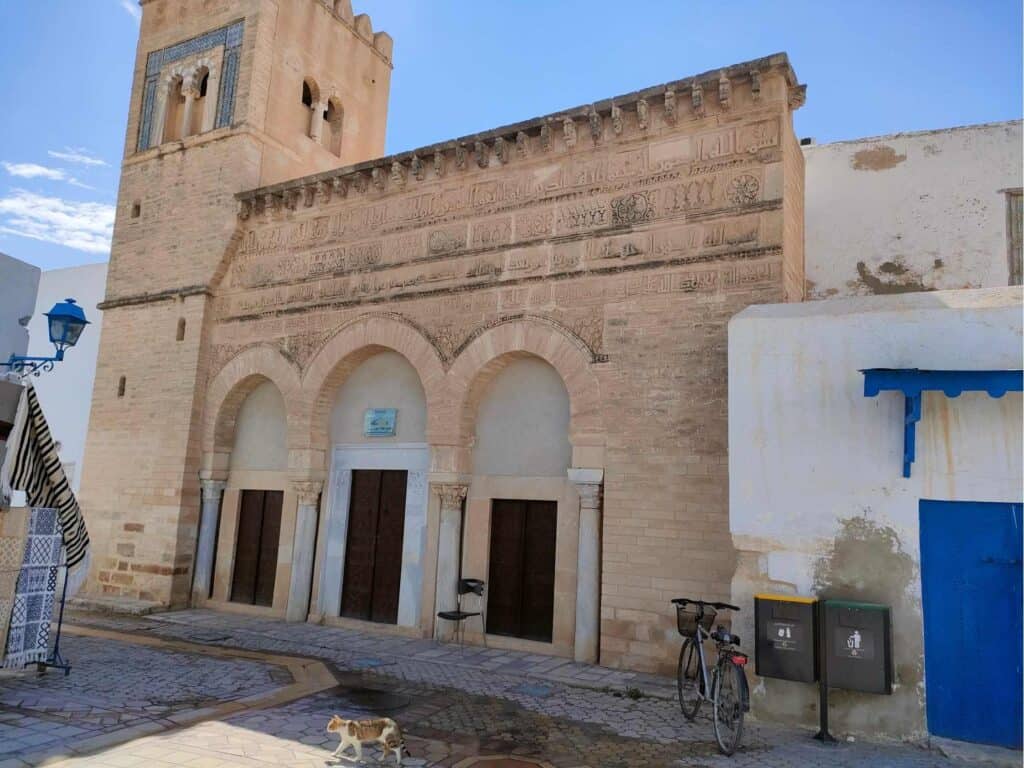
Day 5: El Jem, Sfax, Medinine
El Jem
Who would have thought that one of the largest arenas (148mx 122m) in the world with a capacity of 35,000 is in Tunisia? Most people are surprised to see that such a vast amphitheater exists in North Africa and in such good condition. El Jem is a small settlement, and it is impressive how the structure suddenly appears among the houses. It is worth walking around on the upper levels and climbing to the highest spot for the best view.
El Jem was the shooting scene of the famous movie Monty Python’s Life of Brian, and the sports brand Nike also used it for a television commercial with star football players.
El Jem is a must-see place in Tunisia and should be part of every Tunisia itinerary regardless you plan a shorter or a longer trip.
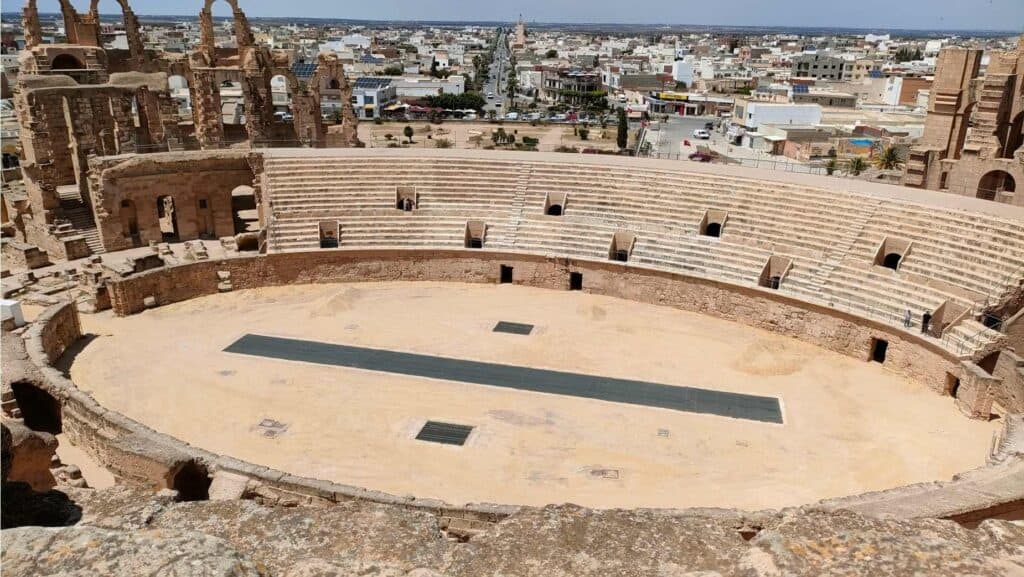
Sfax
You seldom hear about Sfax as a tourist destination. The country’s second biggest city after Tunis is known as an important fishing port and an industrial city, the center of olive and nut processing. Sfax doesn’t have big attractions. However, it has a medina different from any other. The Aghlabid dynasty built it in the 9th century, with the Great Mosque in the center. You may see the mosque’s nicely carved minaret (the small replica of the one in Kairouan), but as usual, non-Muslims are not allowed to enter. The Bab Jebli is an attractive gate leading to the medina from the Aghlabid times.
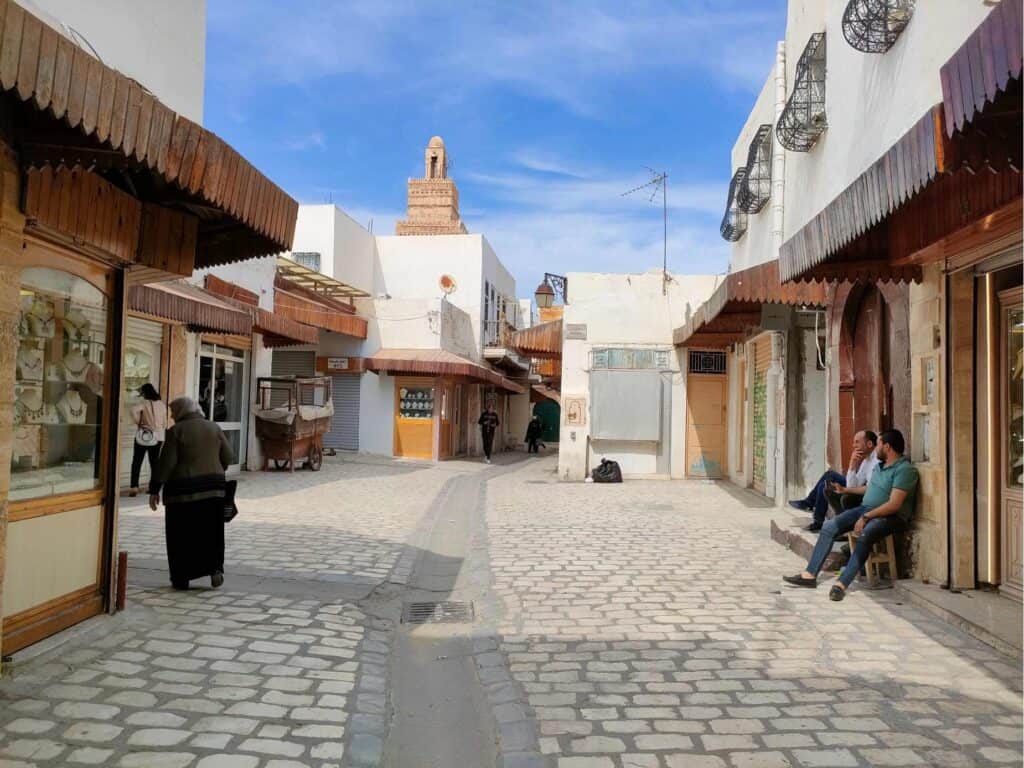
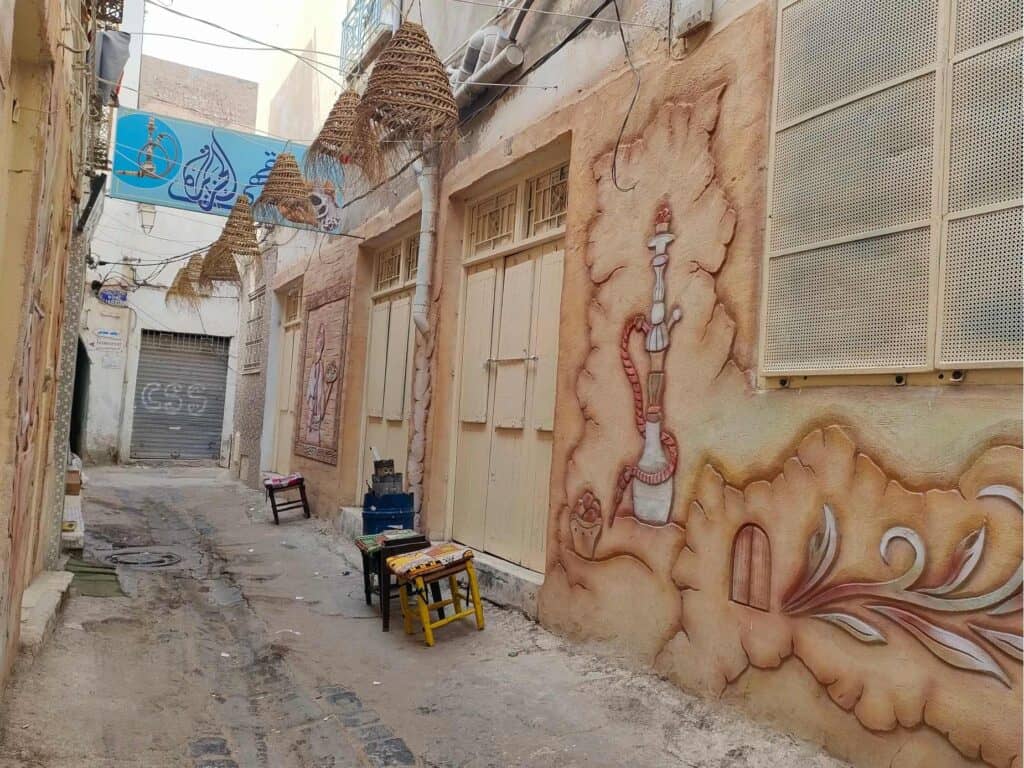
After Sfax, continue to drive to Medinine, a bigger city in the southern part, and ideal to discover the Berber villages around Tatouine the day after.
Sousse – El Jem: 70km (1h)
El-Jem- Sfax: 77km (around 1h)
Sfax- Medinine: 240km (2h 45min)
Where to sleep?
Only a few hotels in the southern part of Tatouine are listed on booking.com. Basically, you have the following options:
Stay in Medinine: There are a couple of hotels as it is the region’s main city.
If you are looking for a low-budget hotel, Hotel Aycha is a good choice (only 70 TND for a twin room outside the peak season. It is simple but clean, and no alcohol is allowed in the hotel). You can find several restaurants and café nearby.
Mid-range: Hotel Lokssour
Hotel Ksar Jouamaa: if you want something special, this unique Ksar (Berber grain store) converted into a hotel-shaped hotel is a good choice. Rooms cost 45-50 EUR per night. Plus, you can book it through booking.com. This is half an hour drive from Medinine.
Day 6: Ksar Hallouf, Ksar Hadada, Chenini, Ksar Ouled
The south of Tunisia is where the Berbers live. Spend the whole day discovering the hilltop Berber villages and ksars (fortified granaries) around Tatouine, one of the unique attractions in Tunisia. What can you actually see?
Ksar: The doors made of palm trunks gave protection from insects and thieves. It was strictly regulated how much the owner could take when he needed it. The vaulted rooms used to store grains (ghorfas) were connected by small flights of stairs. (a series of ghorfas form a multistory ksar).
There are countless such structures, but most are in poor condition. The ones in better condition were mostly built by the Arabs in the 15th and 16th centuries, who adopted the Berber tradition.
These served as a perfect landscape for the shooting of Star Wars, which still attracts fans from all over the world who visit all the shooting spots of the iconic movie series.
I must confess, I haven’t watched Star Wars yet, but even if not all, I also visited the most important ones.
Start or finish the day by checking out the ksar Ommarsia of Medinine!
Ksar Hallouf
This Ksar was built by the Berbers in the 13th century, it is one of the well-preserved structures the Berbers used to store grain.
Ksar Hadada
These are also Berber grain stores converted into a low-budget hotel with private bathrooms, and it appears in the Star Wars movie.
Entrance fee: 2.5 TND
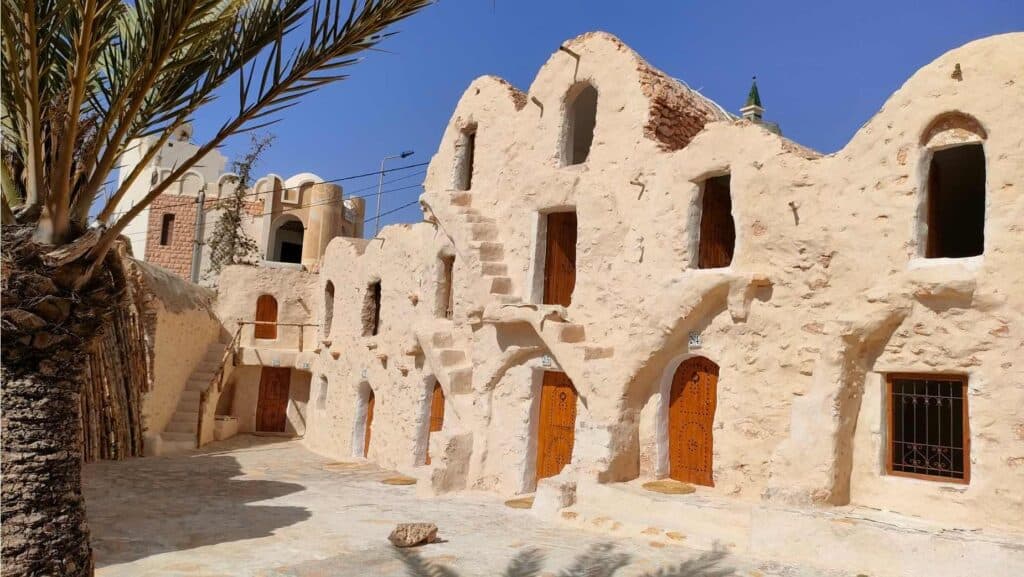
Chenini
This is the most impressive hilltop Berber village. There is one cave-style guesthouse if you wish to spend the night here. It is incredible how they built all that on top of the hill. A series of ghorfas occupy the hilltop, where they used to store the grain. But why were they constructed on the top under extreme difficulties? To defend the crop from the enemy and because the windy location could conserve it for long years. Chenini is still relatively untouched despite becoming popular among tourists, a clear sign that you will find some souvenir shops and a restaurant.
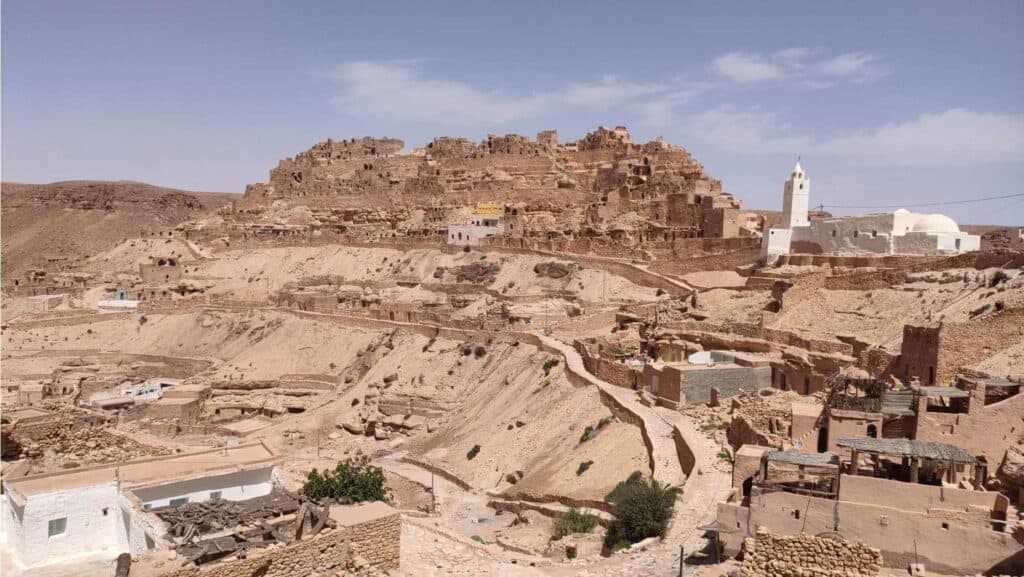
It still has inhabitants, although they moved to the new part at the foot of the hill.
If you wish to visit a similar, though smaller Berber village built against the hillside, you can include Doiret in your program. It has a small restaurant and a mid-range hotel.
Ksar Ouled Soltane
The best example of ksars arranged around two courtyards. It was also featured in the film Star Wars: Episode I – The Phantom Menace as the slave quarters of Mos Espa, where Anakin Skywalker lived as a boy, as I heard.
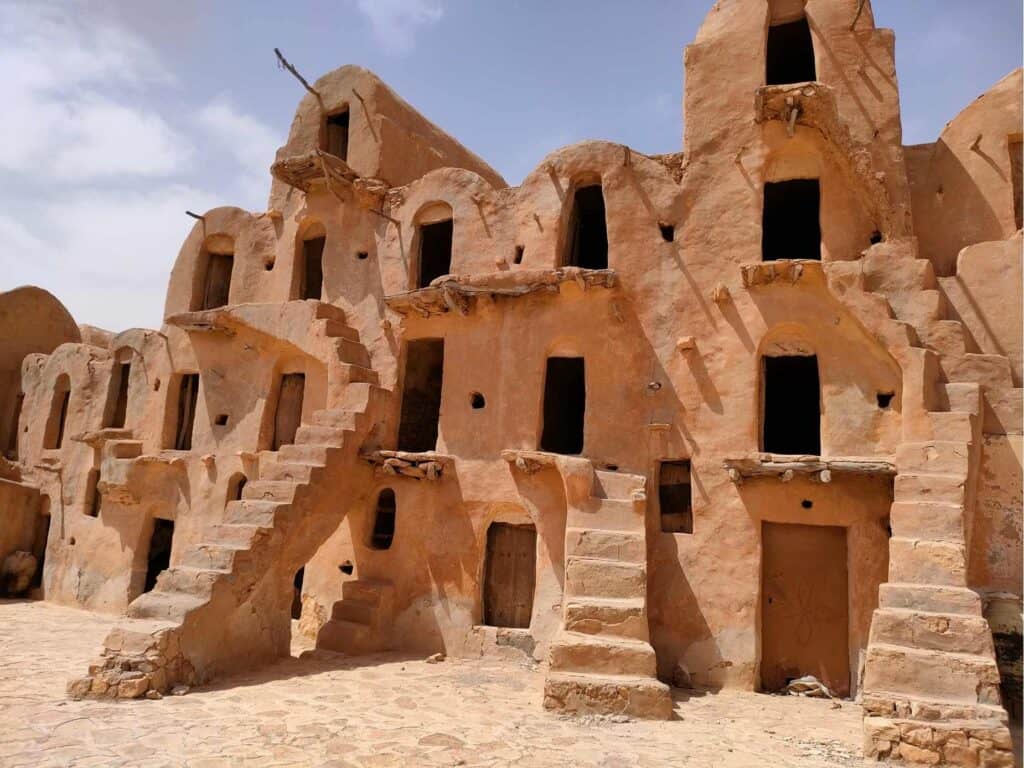
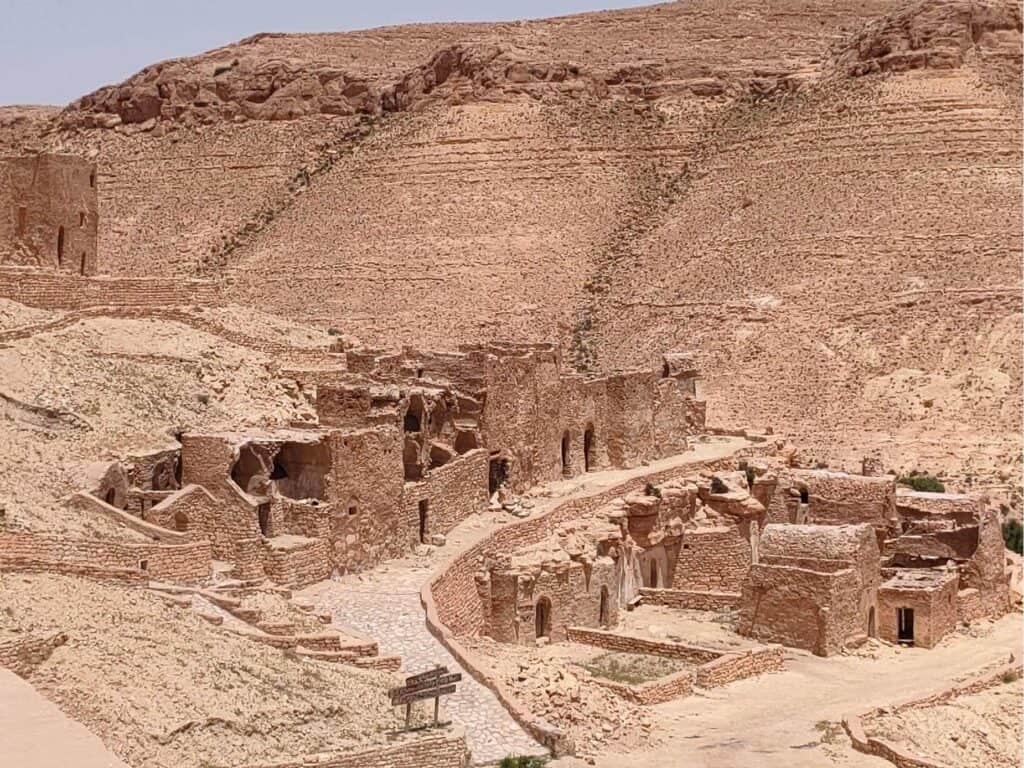
Medinine- Ksar Hallouf: 40km (40min)
Ksar Hallouf- Ksar Hadada: 32km (43min)
Ksar Hadada- Chenini: 35km (32min)
Chenini-Ksar Ouled Soltane: 38km (40min)
Ksar Ouled Soltane- Medinine: 75 km (1h10min)
Day 7: Matmata, Douz, Tozeur
On the way to Tozeur, you should stop in Matmata, which has the most famous examples of Berber houses, plus it is another Star Wars location. The road to Matmata is long but spectacular because you must cross the mountain range through villages and serpentines.
The underground houses provided a pleasant temperature both in summer and winter. Some were converted into mid-range or top-end hotels where tourists can stay at Hotel Marhala, Sidi Idriss, and Les Berbères).
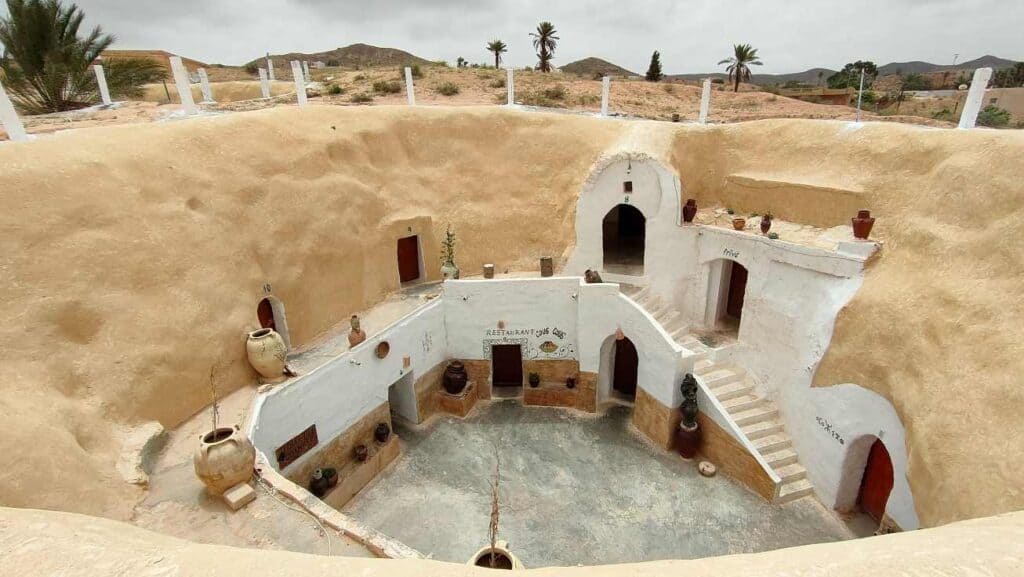
These Berber houses are unique. They look like a crater dug into the terrain some meters deep. The entrance is not seen at first because it leads through a tunnel from the side. The rooms are small caves that surround one or more courtyards.
There are always some guides waiting for the visitors to offer their services. Since apart from Sidi Idriss, the troglodyte home converted into a hotel, there is not much indication of other attractions, you had better take a guide. They offer their services for 20 TND, plus you are expected to leave a tip at the Berbers’ Museum. Here you can have a closer look at the interior of the troglodyte houses and the tunnel leading into it from the outside.
Nearby, Auberge de Tamezret built in a similar style, is also a great place to stay.
Douz is the gateway to the Sahara, with hundreds of thousands of palm trees around. This is a place for travelers to go on a camel and 4×4 tours to the desert and sleep in camp to enjoy the atmosphere. If you are into that, you need to extend your itinerary with one extra day in Douz. The annual Oasis festival can add to your trip if you come in December or January, when it takes place every year.
On the way to Tozeur, you will cross the expansive Chott el Djerid salt lake. They still collect salt at the edge for salt production.
Matmata- Douz: 90km (1h30min)
Douz- Tozeur: 129km (2h)
Day 8: Day trip from Tozeur: Mos Espa, Chebika, Tamerza, Midès
Tozeur is a great place to discover one of the most beautiful regions in Tunisia. The extensive palm groves, canyons, and oasis villages close to the Algerian border are spectacular. There are four standard stops that the full-day local tours include:
Mos Espa – Chebika-Tamerza- Midès
It is worth having a look at the medina of Tozeur, where the buildings are decorated with unique geometric patterns made from brick.
Ong Jmel
You can only get there if you have a 4×4! Otherwise, join a tour organized by a local travel agency. There are plenty of them on the spot. Ong Jamel is also a famous Star Wars shooting place located deep in the desert. We didn’t go there due to lack of time, but this is something that you should visit even if you are not a Star Wars fan, at least for the landscape, especially if you didn’t stop in Douz for a desert trip to get the feeling of that.
Afterward, you will head north of Tozeur to visit the three other places along the same route.
Chebika
Chebika is an oasis village with a café and several souvenir shops at the entrance and along the hiking trail. Most tourists turn back when they reach a small waterfall at the end of the path. But actually, you can continue to make a 20-minute round back to the parking. This way, you get a nice view of the oasis from the top and walk through the old Berber village before arriving in the car park.
On the way to Tamerza, there are some great photo stops along the serpentines.
You will also see the board “Grand Cascade,” (meaning big waterfall) which sounds inviting to leave the main road and make a short stop. We did that, but honestly, this is really not something extraordinary.
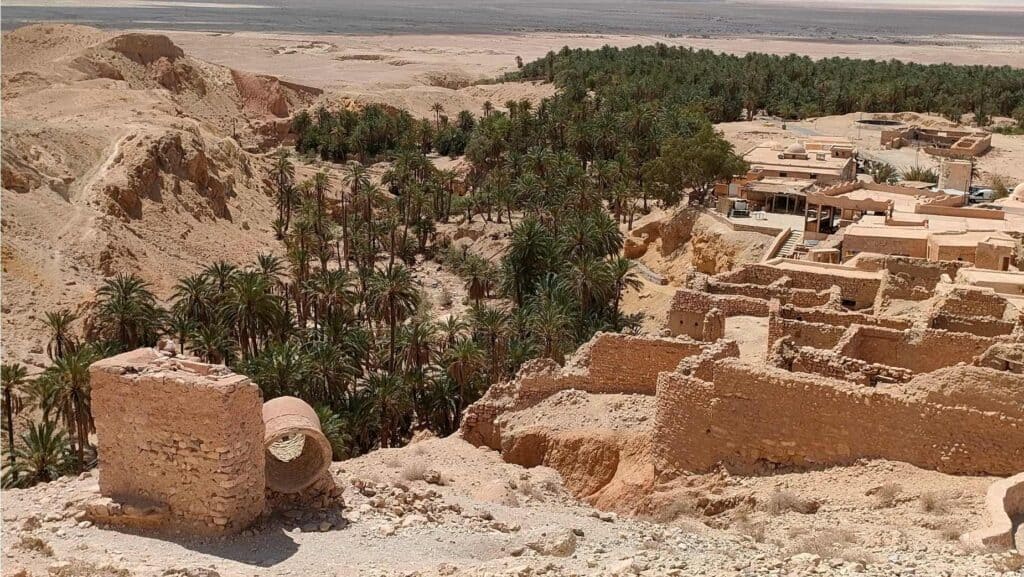
Tamerza
It is another oasis village where you can make a round through the canyon, see the waterfall, and walk among the palm trees. There are a couple of restaurants and cafés around, making it a perfect place to take a break.
Upon arrival, we bumped into a local person, who offered us to show the safest path to descend to the gorge. It was helpful as without any indication, we wouldn’t have found it alone.
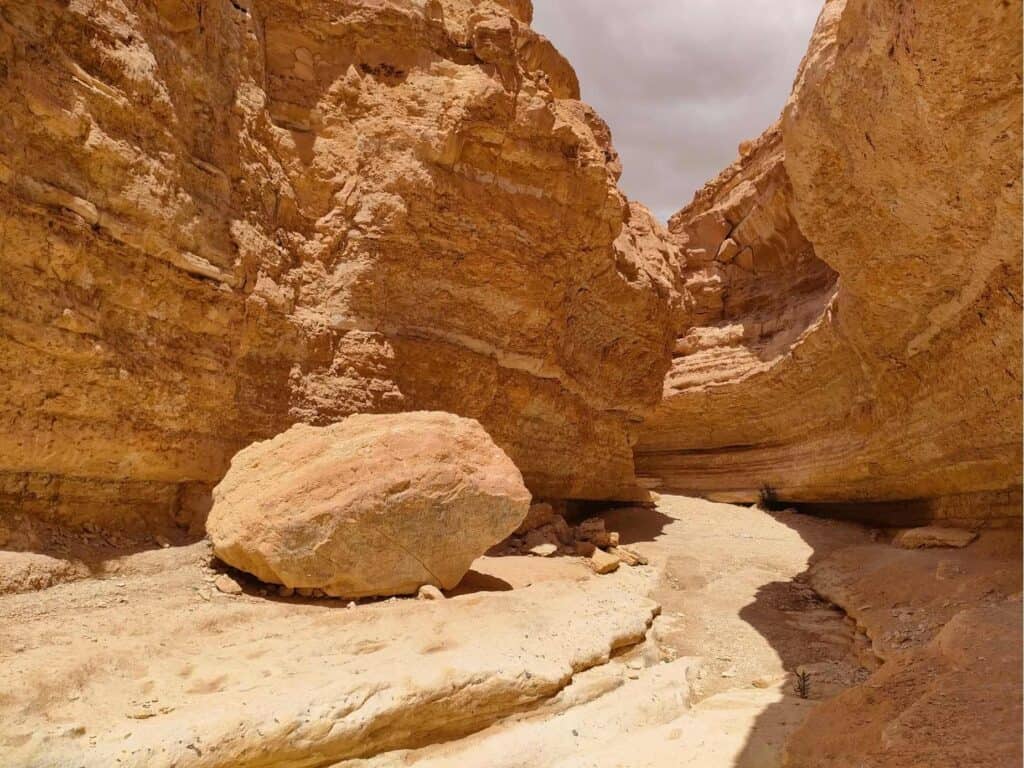
Midès
While in Tamerza, the local guide was useful; here, I would not pay an extra fee for that, even if you can negotiate it for 20 TND.
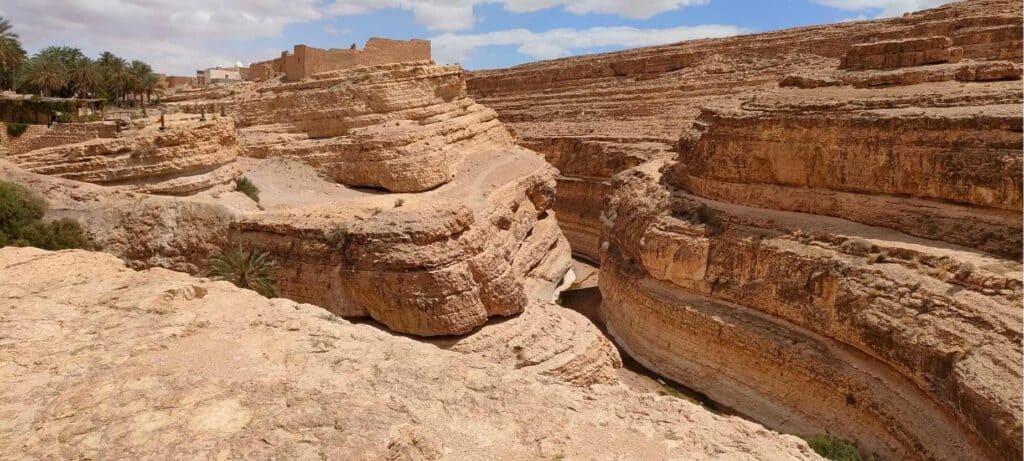
When you arrive at the parking, you take the path along the ruins to the left till you reach the viewpoint of the canyon. The English patient was shot at this place. Then you return and continue in the other direction to see another viewpoint. Both are only a minute’s walk from the parking.
At the end day, you can drive back to Tozeur.
Where to sleep in Tozeur?
Low-budget
Residence Loued is your best choice in a good location close to the center but in a small oasis of the city along a stream with a lot of greenery. On hot days you can use the outside pool. You cannot always book it on booking.com.
Mid-range
Maison D’Hôtes Villa Fatima: It is an apartment in a private house, which gives a unique experience, especially thanks to the friendly welcome of the hosts.
Palm Beach Palace Tozeur: a resort, the perfect place for families and couples, with a swimming pool and bar.
Top End
Dar Nejma: a stylish hotel close to the center
Dar Saida Beya is a traditional Tunisian-style hotel with a central location.
Dar el Sultan Tozeur is a typical Tunisian mansion with a central courtyard and a pool, decorated with pieces of art that lend the house a museum-like appearance.
Day 9: Le Kef (El Kef)
On this day, you drive to the north again, but not directly to Tunis. It is worth making a detour to the west of the country.
The landscape changes on the way to Le Kef that is only 40km away from the Algerian border. Up to now, you may have been wondering where they can grow anything at all. But here, the endless olive trees turn into forests and agricultural areas. The mountain (Tunisian Dorsale) ranges emerging are the extension of the Atlas Mountain range of Morocco.
Le Kef (El Kef)
El Kef, the provisional capital of Tunisia during World War II, is outside the touristic trail of Tunisia. El Kef’s medina occupies the hillside topped by the kasbah (fort). Only a few tourists come to this point, making it enjoyable to discover. Local shops replace souvenir shops; it is a perfect place to observe daily life.
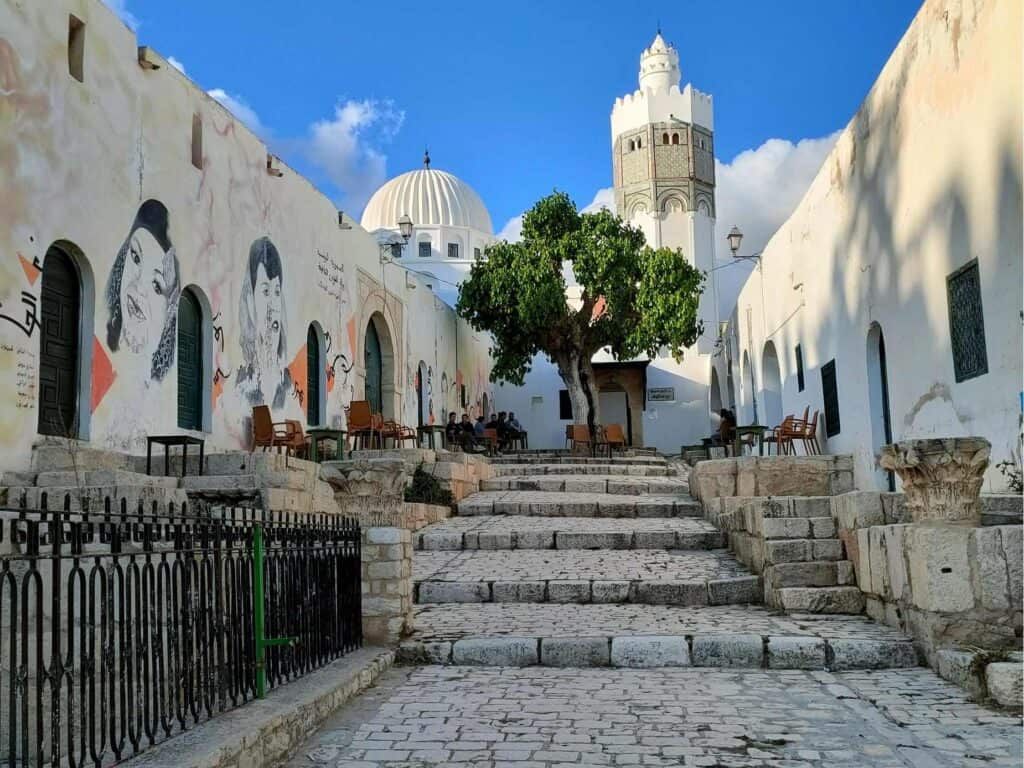
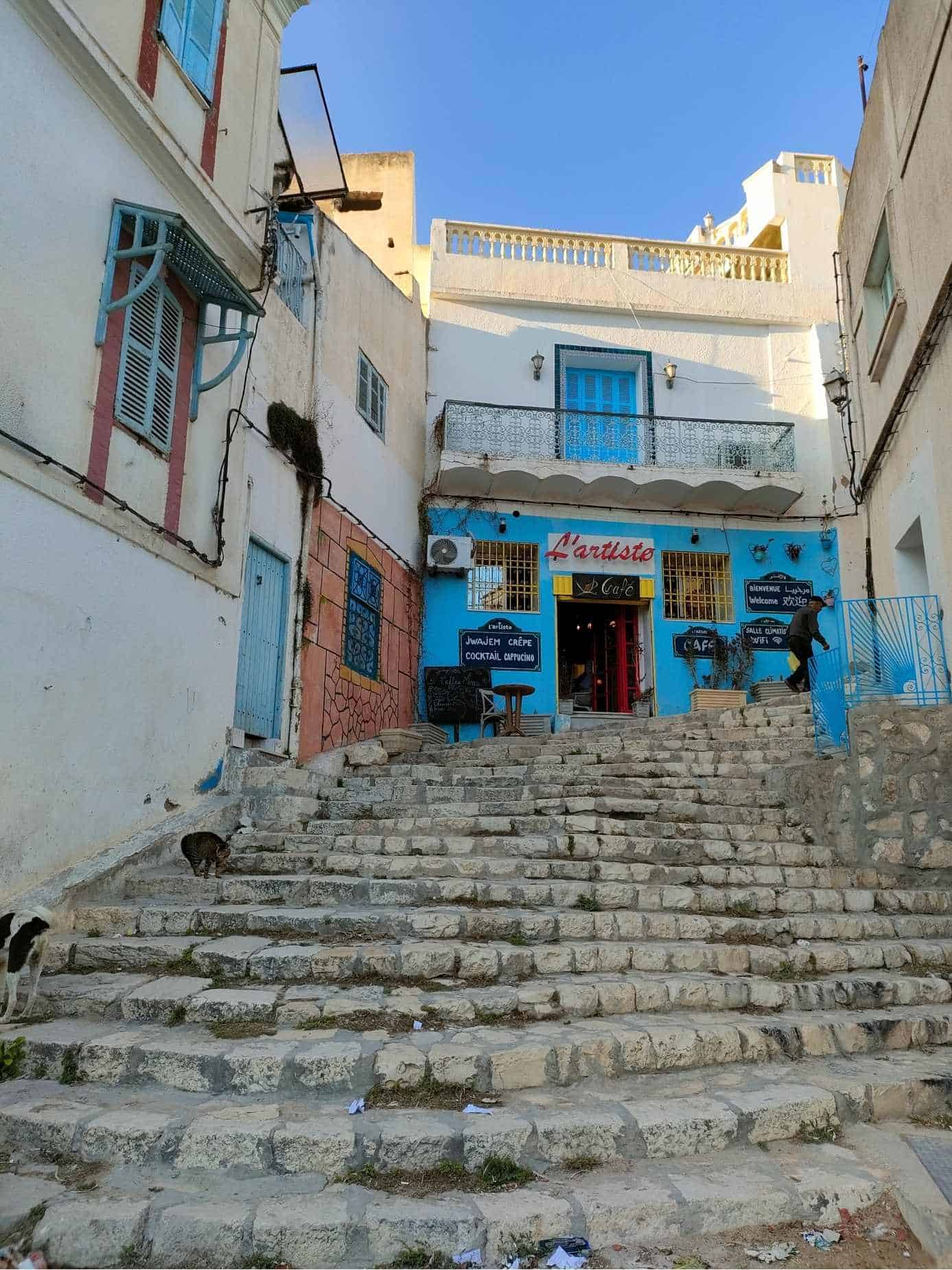
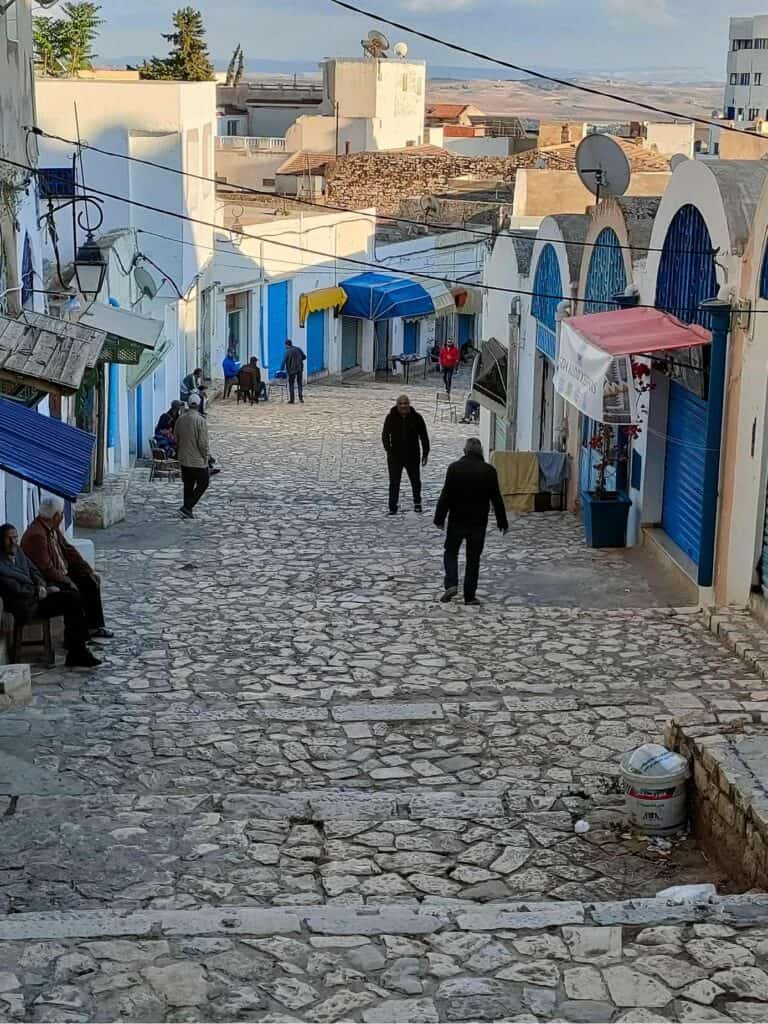
El Kef is also the center of the Sufi movement, so it has a couple of religious monuments, such as the tomb of Sidi Bou Makhlouf, the founder of the Aissawa Brotherhood. The El Qadriya mosque is also important in Sufism.
Visit the fort of El Kef to have the best view of the city and even catch a glimpse of the Jugurtha Tableland, the mountain with a flat top that sharply rises from its surroundings 1200 meters high. The Tableland measures 1500 meters in length and 500m in width. It is the most unique landscape in Tunis. It bears the name of the Numidian king, who used it as his base to attack the Romans in the 1st century BC.
Note: To visit the Jugurtha Tableland, add one day to this Tunisia itinerary. It is possible to get to the top, where shepherds graze their animals and you can also see the holy shrine of a local marabout. You can take a car to the foot of the mountain and climb the stairs afterward to the top. The panorama is excellent, with a view of Algeria.
Where to sleep in El Kef?
Low-budget: Hotel Ramzi 55 TND
Mid-range: Maison D’hôte Dar Saida– a lovely centrally located traditional Tunisian house.
There are more similar types of accommodation in El Kef, though not listed on booking.com
Tozeur: 330km (4h50min)
Day 10: Dougga, Tunis
Dougga is already worth the visit for its location on a hillside surrounded by olive trees, grain fields, and forests.
It was a Numidian town outside Africa province created by the Romans after the Punic wars in 146 BC. Later it became part of the extended province and underwent Romanization. It also changed its name to Dougga.
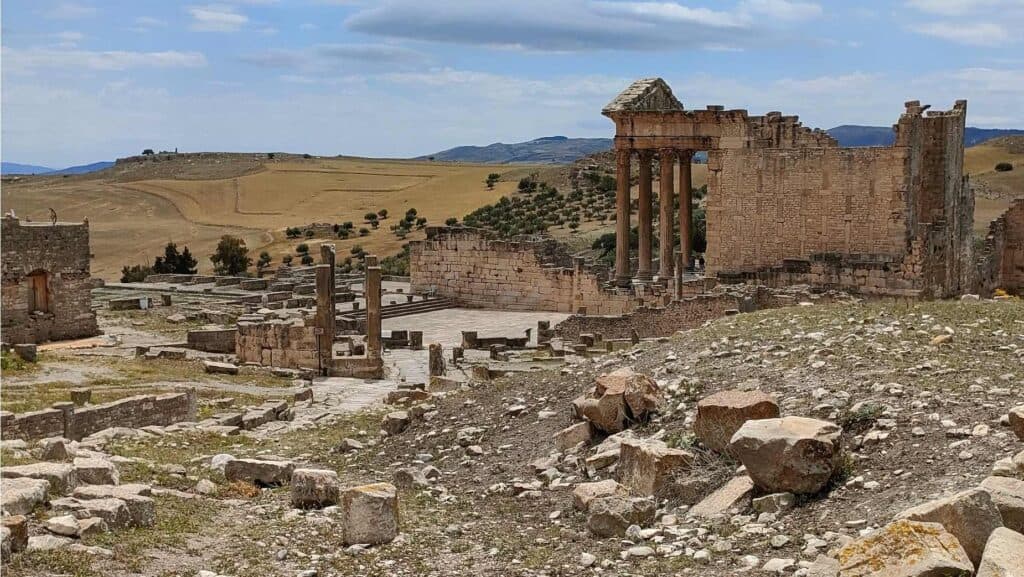
This is the archeological site you don’t want to miss even if you were disappointed by Carthage and don’t plan to make an extra detour for every ruin. It is hard to imagine that it was a small Roman town at the empire’s borders with such an expansion and complexity. It remained much more intact than Carthage because it lied in the middle of the countryside, far from cities. It flourished between the 2nd and 4th centuries with 5000 inhabitants. You can easily spend hours wandering amid the ruins, descending to basements to check out mosaics, columns, and other architectural gems. However, the highlights of the Dougga archeological sites is the Roman theater, the temples of Saturn and Juno Caelestis.
In 46 BC, Caesar annexed the Numidian kingdom to Rome and made it the second Roman province of Africa called Africa Nova.
Although the city was probably founded in the 6th century BC, most of what you see dates to the 2-3rd century during the Roman period. But Dougga’s history is not limited to the Roman period. The Mausoleum of Ateban, for example, dates back to the 2nd BC, a rare instance of Numidian architecture.
People tend to compare it with Baalbek in Lebanon and say it is even more impressive. Dougga is astonishing, but Baalbek still made an even bigger impact on me. But it is a matter of taste. It is definitely something you must include in your Tunisia road trip itinerary.
Like Forum Romanum, Dougga also has a Septimus Severus Arch built in 205 to honor Rome’s first African-born emperor.
El kef- Dougga: 62km (60min)
Dougga- Tunis: 11km (1h45min)
Read about other Arab countries (Iraq, Lebanon, Jordan)
Jordan 5, 7 and 10-day itinerary
Lebanon 5, 7 and 10 day itinerary
As you can see, Tunisia is far more than sandy beaches. It has everything from Berber architecture to Roman ruins and charming medinas. I hope with this Tunisia travel guide and itinerary you are ready for your trip to the most Westernized country of the Arab world. Just try to avoid tourist scams, and you will have a great time!

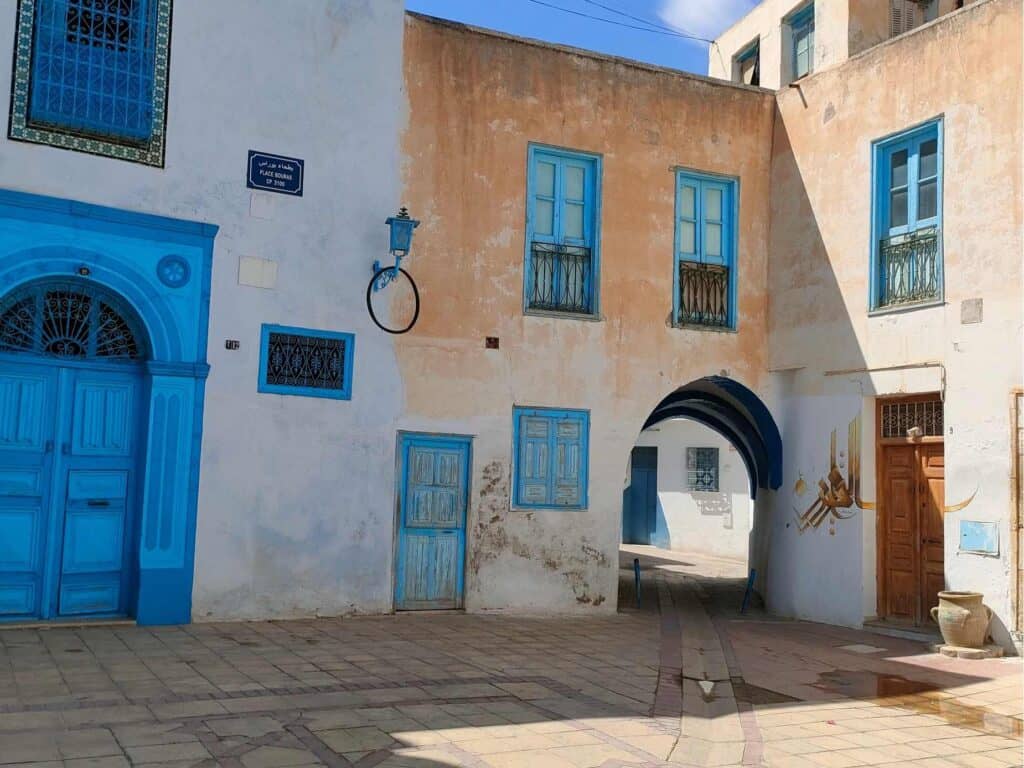

Amazing travelogue
thank you!